Pulitzer Prize Winning Photographs: Part Two
Award winning photographs from 1986 - 2016. Check out Part 1 HERE.
- List View
- Player View
- Grid View
Advertisement
-
1.
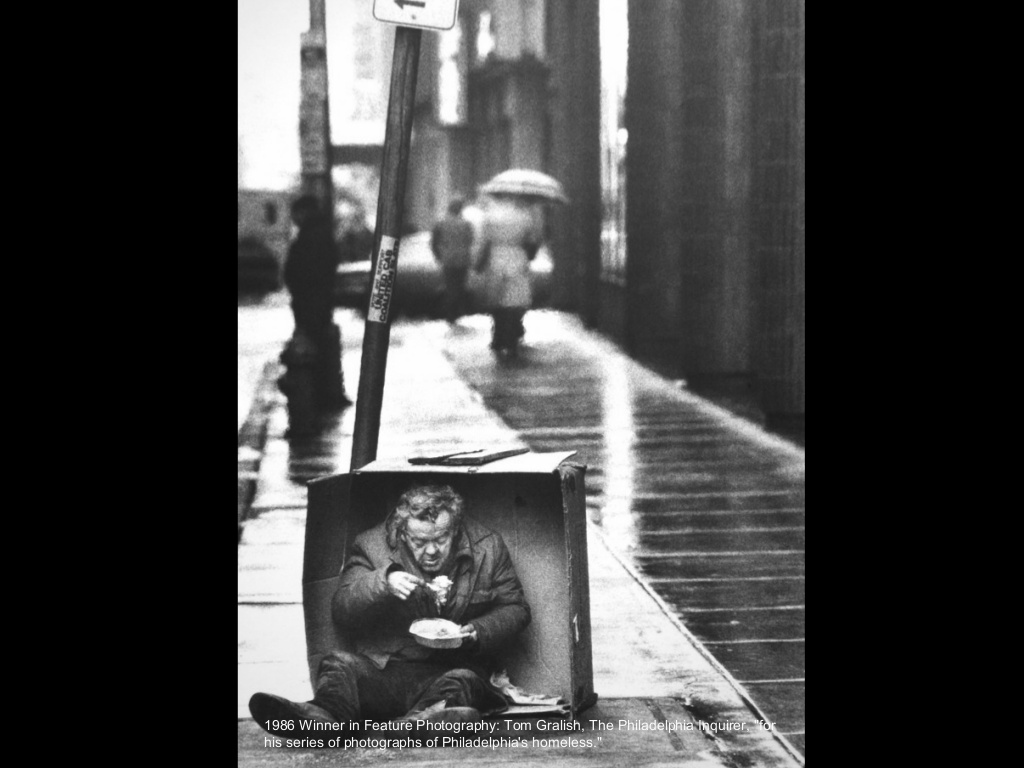 1986: Tom Gralish – “Philadelphia’s Homeless.” In winter of 1985 Gralish visited the city’s homeless and encountered Walter. “I like any kind of food,” said Walter. Whatever’s there. Hotdog one day, the next Chinese food, roast beef sandwich…” Walter lives on a sidewalk heating grate and is one of those guys who is hard to reach because he talks to himself and rants to people on the street. Everyone knows him; people who live and work in the neighborhood give him change. Eventually, Walter allowed Gralish to photograph him. “People like it when you pay attention to them. These guys had disdain for society and the rules, that’s why they objected to the shelters. They saw themselves as the last free men.”
1986: Tom Gralish – “Philadelphia’s Homeless.” In winter of 1985 Gralish visited the city’s homeless and encountered Walter. “I like any kind of food,” said Walter. Whatever’s there. Hotdog one day, the next Chinese food, roast beef sandwich…” Walter lives on a sidewalk heating grate and is one of those guys who is hard to reach because he talks to himself and rants to people on the street. Everyone knows him; people who live and work in the neighborhood give him change. Eventually, Walter allowed Gralish to photograph him. “People like it when you pay attention to them. These guys had disdain for society and the rules, that’s why they objected to the shelters. They saw themselves as the last free men.” -
2.
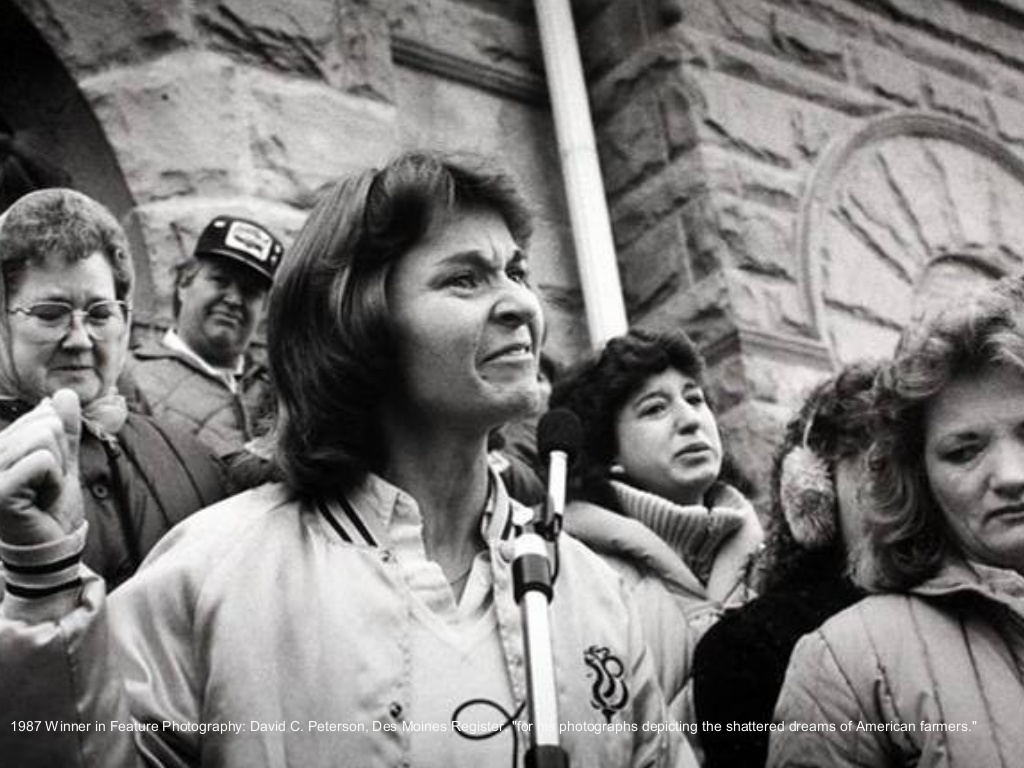 1987: David C. Peterson – “American Farmers.” For photographs depicting the shattered dreams of American farmers.
1987: David C. Peterson – “American Farmers.” For photographs depicting the shattered dreams of American farmers. -
3.
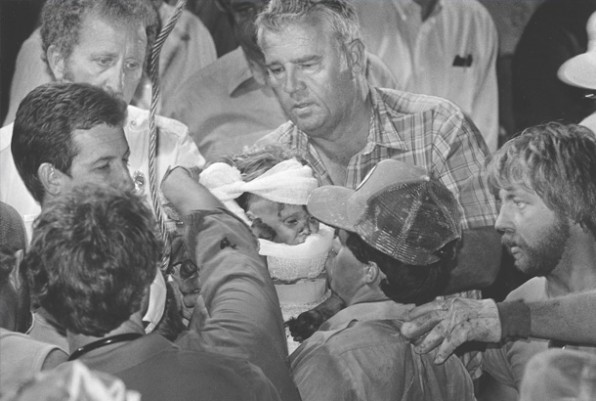 1988: Scott Shaw – “Baby Jessica.” October 14, 1987: Left alone briefly in her aunt’s Midland, Texas, backyard while her mother went inside to answer the phone, 18-month-old Jessica McClure fell into an abandoned 22-foot-deep well. Firemen, paramedics, and a cadre of drillers struggled to reach her as the town of Midland immediately united for the mission. A fledgling CNN picked up local TV station KMID’s video feed of Baby Jessica’s rescue, and the story became the first live round-the-clock news event, garnering an immense worldwide audience. Three days into the rescue, paramedic Robert O’Donnell (who was claustrophobic) wriggled down a parallel shaft dug 28 feet down and through a tunnel to come up under Baby Jessica. But her leg, pinned above her head, held her firmly in place, and O’Donnell couldn’t budge her. Inch by inch, with some patience and K-Y Jelly slathered over the well walls, O’Donnell pulled Jessica free. He handed her to a fireman who wrapped her onto a board and lifted her safely back up into the world, 58 hours after her fall.
1988: Scott Shaw – “Baby Jessica.” October 14, 1987: Left alone briefly in her aunt’s Midland, Texas, backyard while her mother went inside to answer the phone, 18-month-old Jessica McClure fell into an abandoned 22-foot-deep well. Firemen, paramedics, and a cadre of drillers struggled to reach her as the town of Midland immediately united for the mission. A fledgling CNN picked up local TV station KMID’s video feed of Baby Jessica’s rescue, and the story became the first live round-the-clock news event, garnering an immense worldwide audience. Three days into the rescue, paramedic Robert O’Donnell (who was claustrophobic) wriggled down a parallel shaft dug 28 feet down and through a tunnel to come up under Baby Jessica. But her leg, pinned above her head, held her firmly in place, and O’Donnell couldn’t budge her. Inch by inch, with some patience and K-Y Jelly slathered over the well walls, O’Donnell pulled Jessica free. He handed her to a fireman who wrapped her onto a board and lifted her safely back up into the world, 58 hours after her fall. -
4.
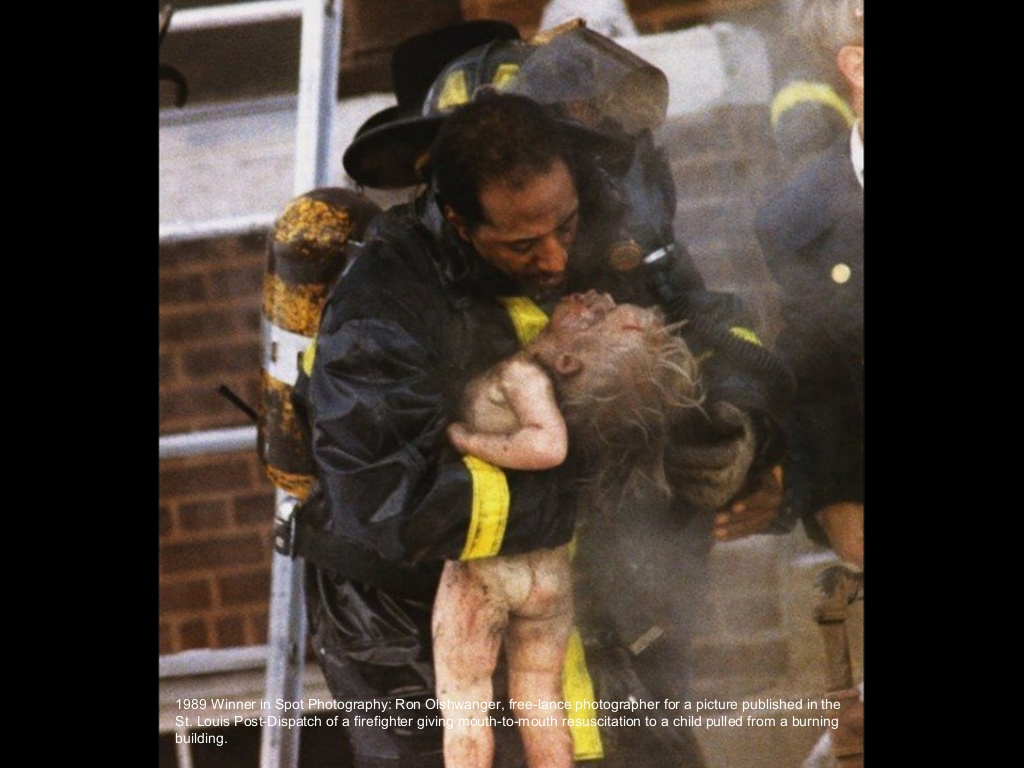 1989: Ron Olshwanger – “Rescue Attempt.” Olshwanger captured an image of St Louis firefighter Adam Long giving mouth-to-mouth resuscitation to the limp form of 2 year old Patricia Pettus as he rushed her from a burning apartment on Dec 30, 1988. The next day, as she clung to life at St. Louis Children's Hospital, the photo ran on the front page of the Post-Dispatch. Before long, it was published in newspapers worldwide, and chronicled a moment that would change fire safety standards around the world. Six days after the fire, Patricia died. The following spring, Olshwanger was presented the prestigious Pulitzer Prize for spot news photography. As for Long, the incident branded him a hero — he received a Medal of Honor — though he didn't feel very heroic. "For about a year, I second-guessed myself: 'Did I really do all that I could have done?'" Long said. The two men grieved when she died. They attended her funeral together. And as difficult as it was to accept her loss, each found meaning in her death. "The little girl did not die in vain," said Olshwanger, who said he still receives requests for copies of the photo. "To me, she is a hero because people are going out and buying smoke detectors because of what they see in that photo." The fire also sparked a friendship between Olshwanger and Long that has remained strong for over 20 years.
1989: Ron Olshwanger – “Rescue Attempt.” Olshwanger captured an image of St Louis firefighter Adam Long giving mouth-to-mouth resuscitation to the limp form of 2 year old Patricia Pettus as he rushed her from a burning apartment on Dec 30, 1988. The next day, as she clung to life at St. Louis Children's Hospital, the photo ran on the front page of the Post-Dispatch. Before long, it was published in newspapers worldwide, and chronicled a moment that would change fire safety standards around the world. Six days after the fire, Patricia died. The following spring, Olshwanger was presented the prestigious Pulitzer Prize for spot news photography. As for Long, the incident branded him a hero — he received a Medal of Honor — though he didn't feel very heroic. "For about a year, I second-guessed myself: 'Did I really do all that I could have done?'" Long said. The two men grieved when she died. They attended her funeral together. And as difficult as it was to accept her loss, each found meaning in her death. "The little girl did not die in vain," said Olshwanger, who said he still receives requests for copies of the photo. "To me, she is a hero because people are going out and buying smoke detectors because of what they see in that photo." The fire also sparked a friendship between Olshwanger and Long that has remained strong for over 20 years. -
5.
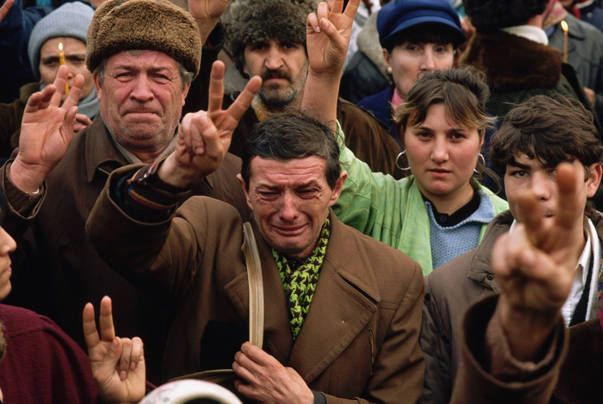 1990: David C. Turnley – “The Romanian Revolution.” Romanian people celebrating the end of communism with tears in their eyes and peace signs in the air.
1990: David C. Turnley – “The Romanian Revolution.” Romanian people celebrating the end of communism with tears in their eyes and peace signs in the air. -
6.
 1991: Greg Marinovich – “Fiery Death in South Africa.” A man hacks at Lindsay Tshabalala, a Zulu man beaten and burned to death as a suspected Inkatha faction member by African National Congress supporters in Soweto, South Africa, Sept. 15, 1990. More than 3,000 people died in 1990 as a result of ANC-Inkatha violence that was provoked by a state-sponsored destabilization program prior to South Africa’s first democratic elections in 1994. Elements of the South African government, in a shadow alliance with Zulu Inkatha and security forces, promoted violence against the ANC in the black townships.
1991: Greg Marinovich – “Fiery Death in South Africa.” A man hacks at Lindsay Tshabalala, a Zulu man beaten and burned to death as a suspected Inkatha faction member by African National Congress supporters in Soweto, South Africa, Sept. 15, 1990. More than 3,000 people died in 1990 as a result of ANC-Inkatha violence that was provoked by a state-sponsored destabilization program prior to South Africa’s first democratic elections in 1994. Elements of the South African government, in a shadow alliance with Zulu Inkatha and security forces, promoted violence against the ANC in the black townships. -
7.
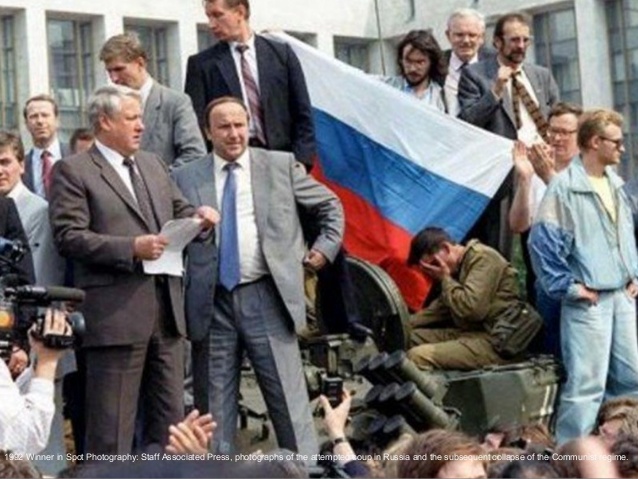 1992: Olga Shalygin, Liu Heung Shing, Czarek Sokolowski, Boris Yurchenko and Alexander Zemlianichenko – “The Collapse of the Soviet Union.” For a series of pictures on the attempted coup in the Soviet Union and the collapse of the Communist regime. In the above picture: Boris Yeltsin, president of the Russian Federation, makes a speech from atop a tank in front of the Russian parliament building in Moscow, U.S.S.R., Monday, Aug. 19, 1991. Yeltsin called on the Russian people to resist the communist hard liners in the Soviet coup.
1992: Olga Shalygin, Liu Heung Shing, Czarek Sokolowski, Boris Yurchenko and Alexander Zemlianichenko – “The Collapse of the Soviet Union.” For a series of pictures on the attempted coup in the Soviet Union and the collapse of the Communist regime. In the above picture: Boris Yeltsin, president of the Russian Federation, makes a speech from atop a tank in front of the Russian parliament building in Moscow, U.S.S.R., Monday, Aug. 19, 1991. Yeltsin called on the Russian people to resist the communist hard liners in the Soviet coup. -
8.
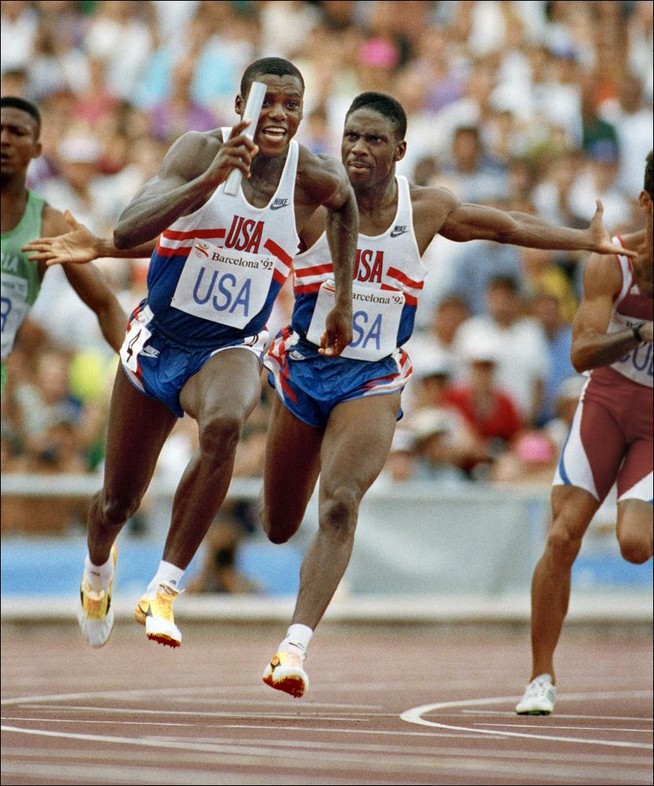 1993: William Snyder and Ken Geiger – “Olympic Coverage.” For a series of pictures documenting the 1992 Summer Olympics held in Barcelona, Spain.
1993: William Snyder and Ken Geiger – “Olympic Coverage.” For a series of pictures documenting the 1992 Summer Olympics held in Barcelona, Spain. -
9.
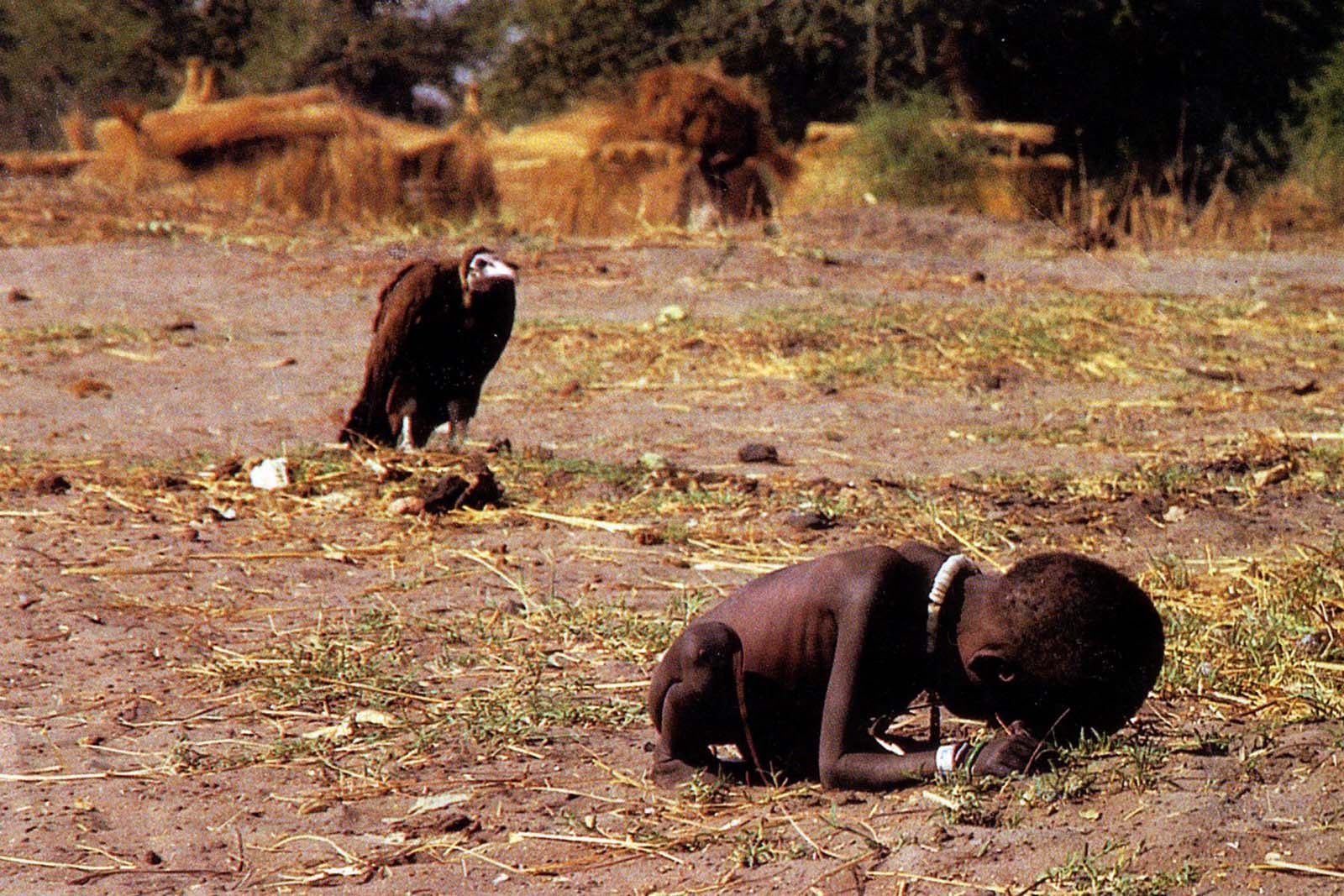 1994: Kevin Carter – “Vulture and Child.” Carter traveled to Sudan to cover the relentless East African famine. He found people so weakened by hunger that they were dying at the rate of 20 per hour. Carter found a young girl trying to make her way to a feeding station and readied his camera. Suddenly, a vulture landed nearby. Carter took the photo before chasing the bird away. Afterward, he sat under a tree and cried. The picture ran in newspapers worldwide, and Carter received outraged letters and angry phone calls demanding to know why he didn’t pick up the child. But journalists in Sudan were told not to touch the famine victims because of the risk of disease transmission. This was no comfort to Carter, who later told a friend, “I’m really, really sorry I didn’t pick the child up.” The controversy and other personal problems overwhelmed him. On July 16, 1994, police found Carter dead in an apartment of an apparent suicide. He was 33 years old.
1994: Kevin Carter – “Vulture and Child.” Carter traveled to Sudan to cover the relentless East African famine. He found people so weakened by hunger that they were dying at the rate of 20 per hour. Carter found a young girl trying to make her way to a feeding station and readied his camera. Suddenly, a vulture landed nearby. Carter took the photo before chasing the bird away. Afterward, he sat under a tree and cried. The picture ran in newspapers worldwide, and Carter received outraged letters and angry phone calls demanding to know why he didn’t pick up the child. But journalists in Sudan were told not to touch the famine victims because of the risk of disease transmission. This was no comfort to Carter, who later told a friend, “I’m really, really sorry I didn’t pick the child up.” The controversy and other personal problems overwhelmed him. On July 16, 1994, police found Carter dead in an apartment of an apparent suicide. He was 33 years old. -
10.
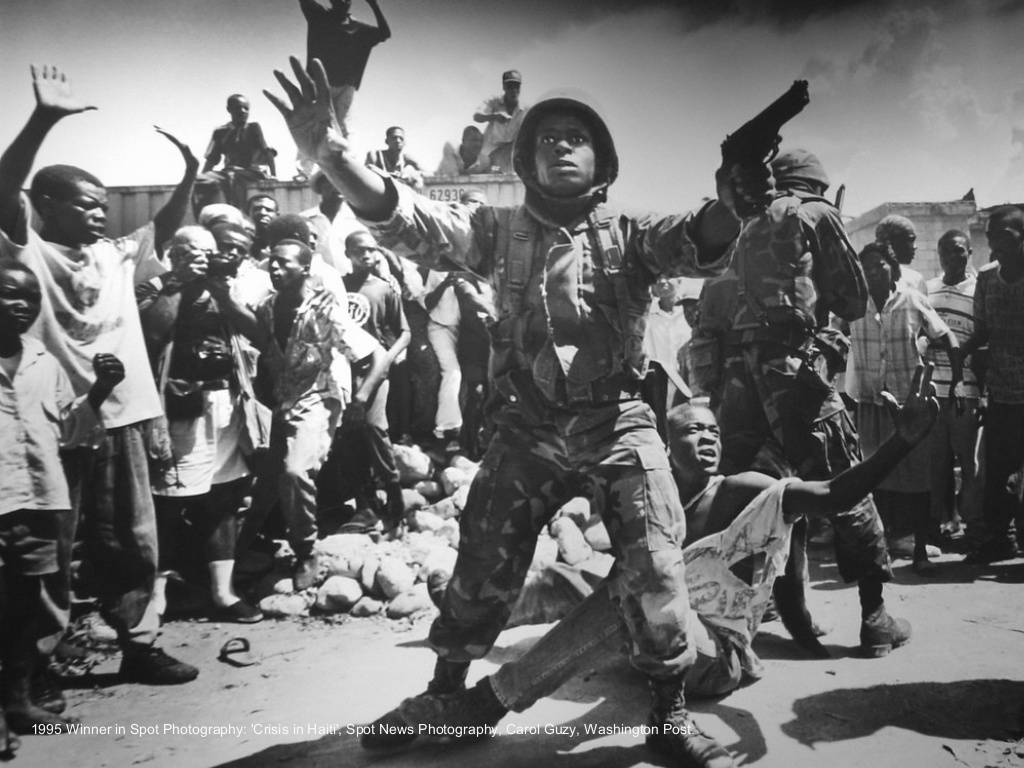 1995: Carol Guzy – “Crisis in Haiti.” On Dec 16, 1990, Bertrand Aristide won Haiti’s first free presidential election. Less than a year later he was deposed and sent into exile. The U.S. imposed a trade embargo and thousands of Haitians fled. In September 1994, U.S. Troops landed in Haiti to help return Aristide to power. In Port-Au-Prince there was a joyous democracy march. Then someone threw a grenade into the crowd. People were killed and wounded. There was shooting, but no one could figure out where it was coming from. During the chaos, Guzy captured the above image showing a man on the ground with his arm raised. The crowd thought he had thrown the grenade and were trying to attack him. Two U.S. Troops were trying to protect him.
1995: Carol Guzy – “Crisis in Haiti.” On Dec 16, 1990, Bertrand Aristide won Haiti’s first free presidential election. Less than a year later he was deposed and sent into exile. The U.S. imposed a trade embargo and thousands of Haitians fled. In September 1994, U.S. Troops landed in Haiti to help return Aristide to power. In Port-Au-Prince there was a joyous democracy march. Then someone threw a grenade into the crowd. People were killed and wounded. There was shooting, but no one could figure out where it was coming from. During the chaos, Guzy captured the above image showing a man on the ground with his arm raised. The crowd thought he had thrown the grenade and were trying to attack him. Two U.S. Troops were trying to protect him. -
11.
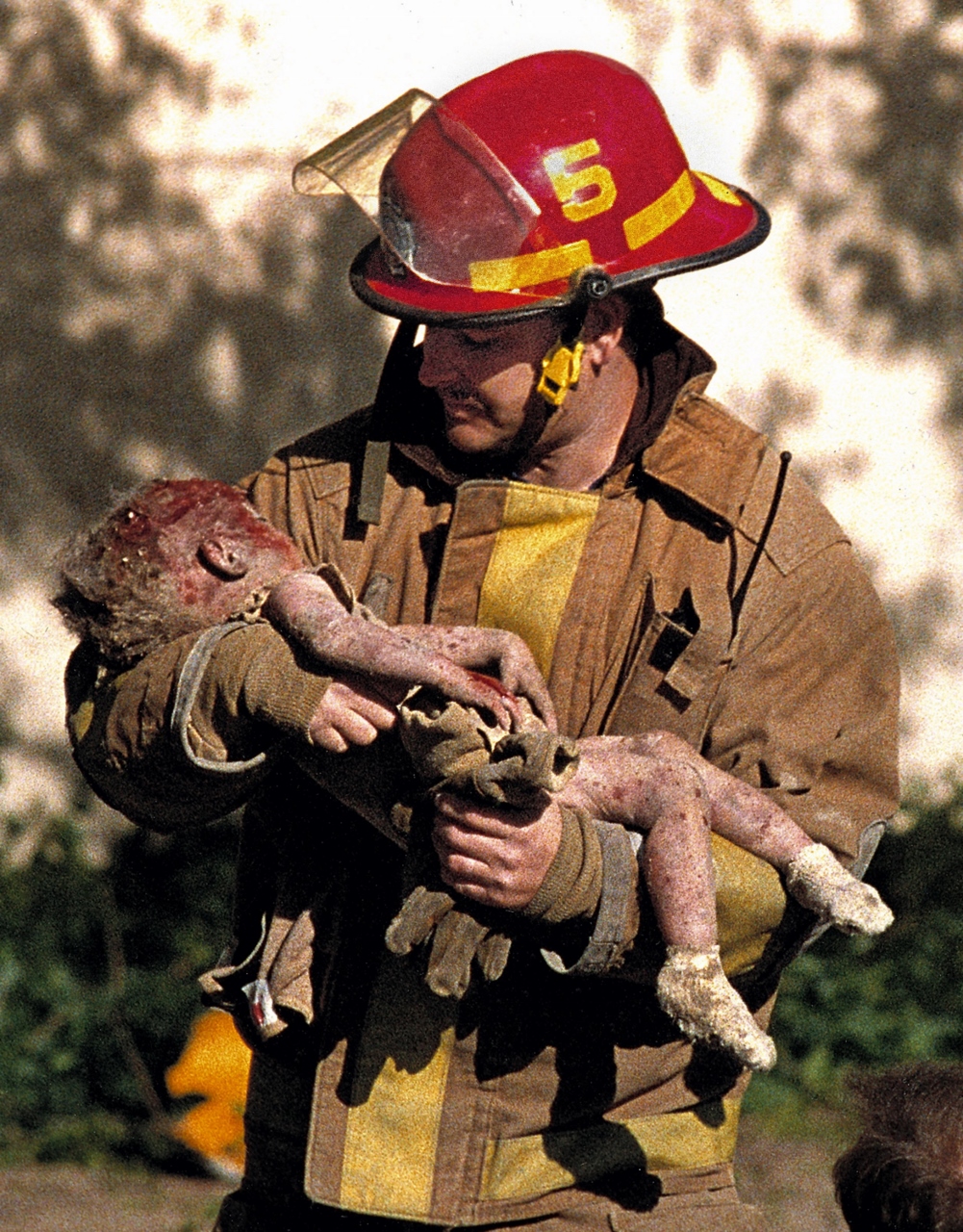 1996: Charles Porter – “Oklahoma City Bombing.” On April 19, 1995, Porter was at work in downtown Oklahoma City when the building he was in was rocked by an explosion. Porter grabbed his camera and ran toward the explosion, seeing injured people, broken glass and debris along the way. When Porter reached the Alfred P. Murrah Federal Building, he saw a police officer hand something to a firefighter. The firefighter turned and Porter saw he was carrying an infant. Porter took one shot. The explosion injured more than 500 people and killed 168, including the child in Porter’s picture, Baylee Almon, who celebrated her first birthday the day before.
1996: Charles Porter – “Oklahoma City Bombing.” On April 19, 1995, Porter was at work in downtown Oklahoma City when the building he was in was rocked by an explosion. Porter grabbed his camera and ran toward the explosion, seeing injured people, broken glass and debris along the way. When Porter reached the Alfred P. Murrah Federal Building, he saw a police officer hand something to a firefighter. The firefighter turned and Porter saw he was carrying an infant. Porter took one shot. The explosion injured more than 500 people and killed 168, including the child in Porter’s picture, Baylee Almon, who celebrated her first birthday the day before. -
12.
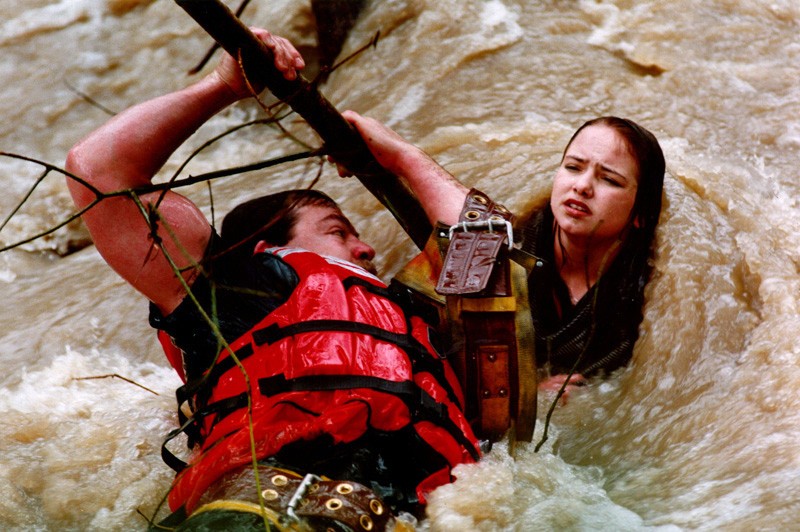 1997: Annie Wells – “Firefighter Rescues Teenager.” On Feb 4, 1996, Wells snapped this picture of Santa Rosa firefighter Don Wells grabbing a tree after diving into flooded Matanzas Creek to rescue 15 year old Marglyn Paseka from the rapidly rising water. Paseka got too close to the swollen creek that ran past the Bennet Valley Apartment Complex where she lived, and fell in. Wells was able to secure a safety harness around Paseka who was then pulled to safety.
1997: Annie Wells – “Firefighter Rescues Teenager.” On Feb 4, 1996, Wells snapped this picture of Santa Rosa firefighter Don Wells grabbing a tree after diving into flooded Matanzas Creek to rescue 15 year old Marglyn Paseka from the rapidly rising water. Paseka got too close to the swollen creek that ran past the Bennet Valley Apartment Complex where she lived, and fell in. Wells was able to secure a safety harness around Paseka who was then pulled to safety. -
13.
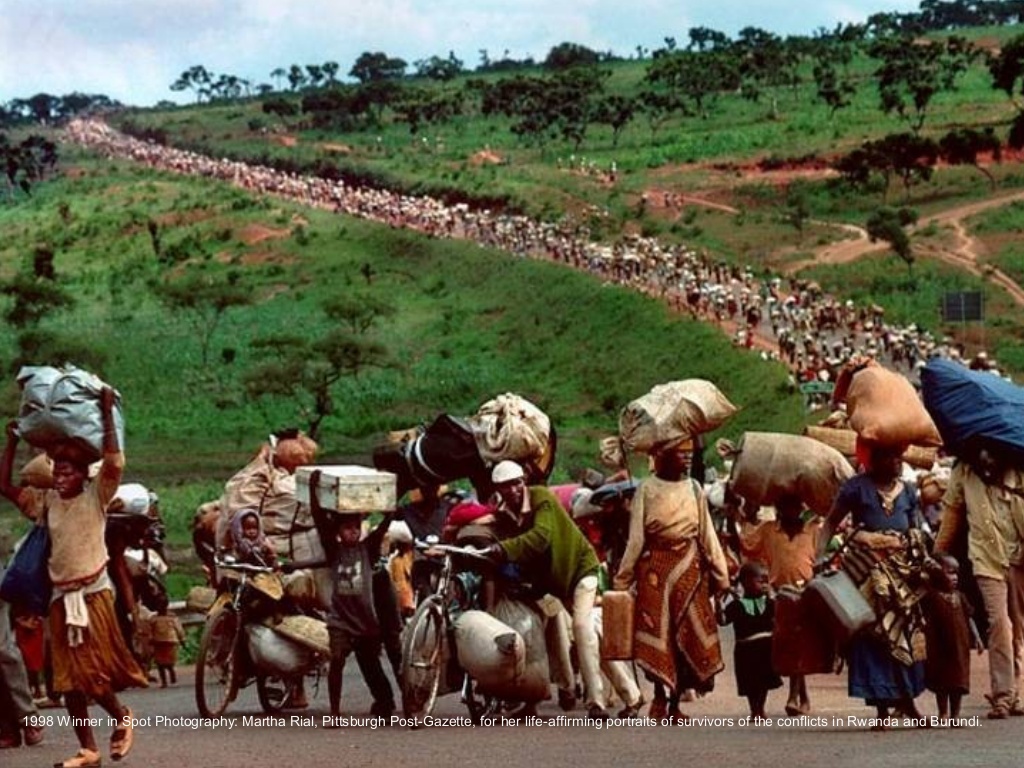 1998: Martha Rial – “Trek of Tears: An African Journey.” The line of refugees reaches to the horizon, victims of the centuries old warfare between Africa’s Hutu and Tutsi tribes. Most are women and children. Many are hungry. Said Rial: “The stream of refuges you see here had been walking for almost 24 hours. The previous evening they heard word that the Tanzanian government was going to force them to leave. They were trying to flee, to go deeper into the bush. They were forced back by the troops into Rwanda. the group is led by a handful of militia guys. Men who are the leaders in the communities. They may or may not be wanted for genocide.”
1998: Martha Rial – “Trek of Tears: An African Journey.” The line of refugees reaches to the horizon, victims of the centuries old warfare between Africa’s Hutu and Tutsi tribes. Most are women and children. Many are hungry. Said Rial: “The stream of refuges you see here had been walking for almost 24 hours. The previous evening they heard word that the Tanzanian government was going to force them to leave. They were trying to flee, to go deeper into the bush. They were forced back by the troops into Rwanda. the group is led by a handful of militia guys. Men who are the leaders in the communities. They may or may not be wanted for genocide.” -
14.
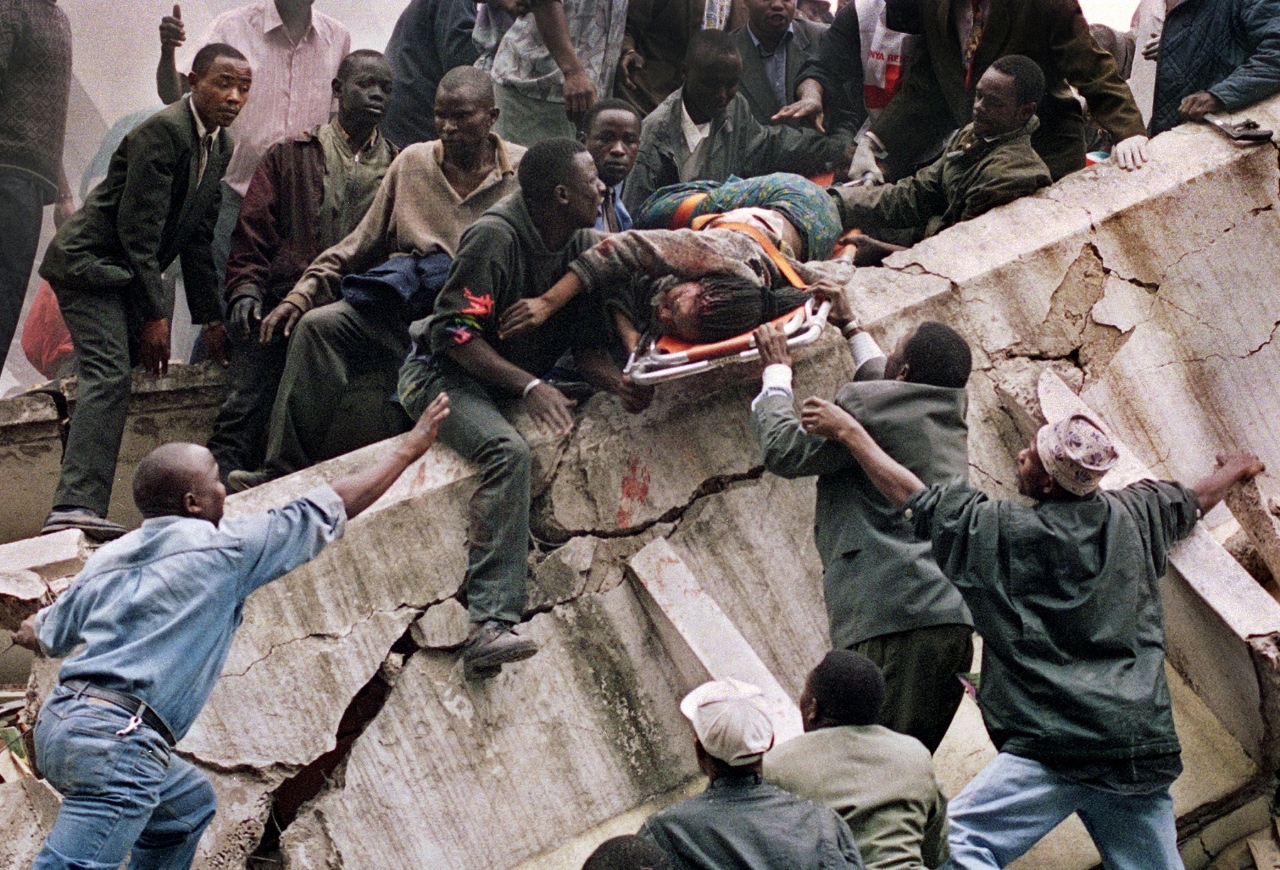 1999: Sayyid Azim, Jean-Marc Bouju, Dave Caulkin, Brennan Linsley, John McConnico and Khalil Senosi – “Series of photos depicting the aftermath of the bombing of the US Embassies in Kenya and Tanzania. In this picture, rescue workers carry Susan Francisca Murianki, a U.S. Embassy office worker, from the rubble of a collapsed building next to the embassy in Nairobi on Aug. 7, 1998, after terrorist bombs exploded minutes apart outside the U.S. embassies in the Kenyan and Tanzanian capitals. In Nairobi alone more than 200 people were killed and about 4,000 wounded. The Pulizter was awarded for this portfolio showing both the horror and humanity triggered by the bombings.
1999: Sayyid Azim, Jean-Marc Bouju, Dave Caulkin, Brennan Linsley, John McConnico and Khalil Senosi – “Series of photos depicting the aftermath of the bombing of the US Embassies in Kenya and Tanzania. In this picture, rescue workers carry Susan Francisca Murianki, a U.S. Embassy office worker, from the rubble of a collapsed building next to the embassy in Nairobi on Aug. 7, 1998, after terrorist bombs exploded minutes apart outside the U.S. embassies in the Kenyan and Tanzanian capitals. In Nairobi alone more than 200 people were killed and about 4,000 wounded. The Pulizter was awarded for this portfolio showing both the horror and humanity triggered by the bombings. -
15.
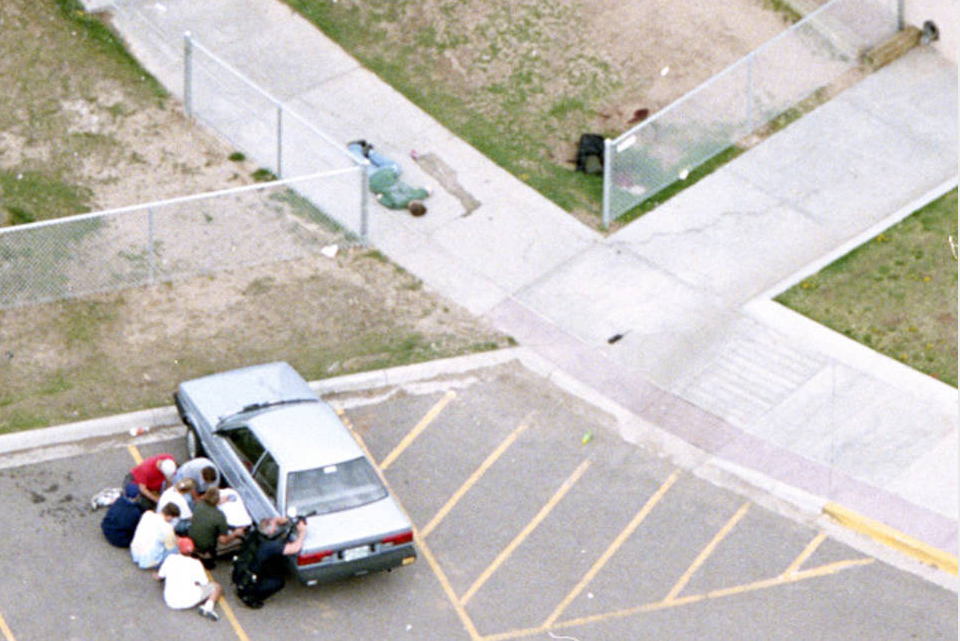 2000: Photo Staff of the Rocky Mountain News – “Columbine School Shooting.” The photo staff was awarded the Pulitzer in breaking news photography for a series of pictures documenting the shooting at Columbine High School as events unfolded. Pictured above: Daniel Rohrbough lies dead on a sidewalk, soda from a can he dropped trickling downhill near him. At left, students crouch behind a car with a police officer who aims his gun at the school. (Rodolfo Gonzalez/Rocky Mountain News - April 20, 1999).
2000: Photo Staff of the Rocky Mountain News – “Columbine School Shooting.” The photo staff was awarded the Pulitzer in breaking news photography for a series of pictures documenting the shooting at Columbine High School as events unfolded. Pictured above: Daniel Rohrbough lies dead on a sidewalk, soda from a can he dropped trickling downhill near him. At left, students crouch behind a car with a police officer who aims his gun at the school. (Rodolfo Gonzalez/Rocky Mountain News - April 20, 1999). -
16.
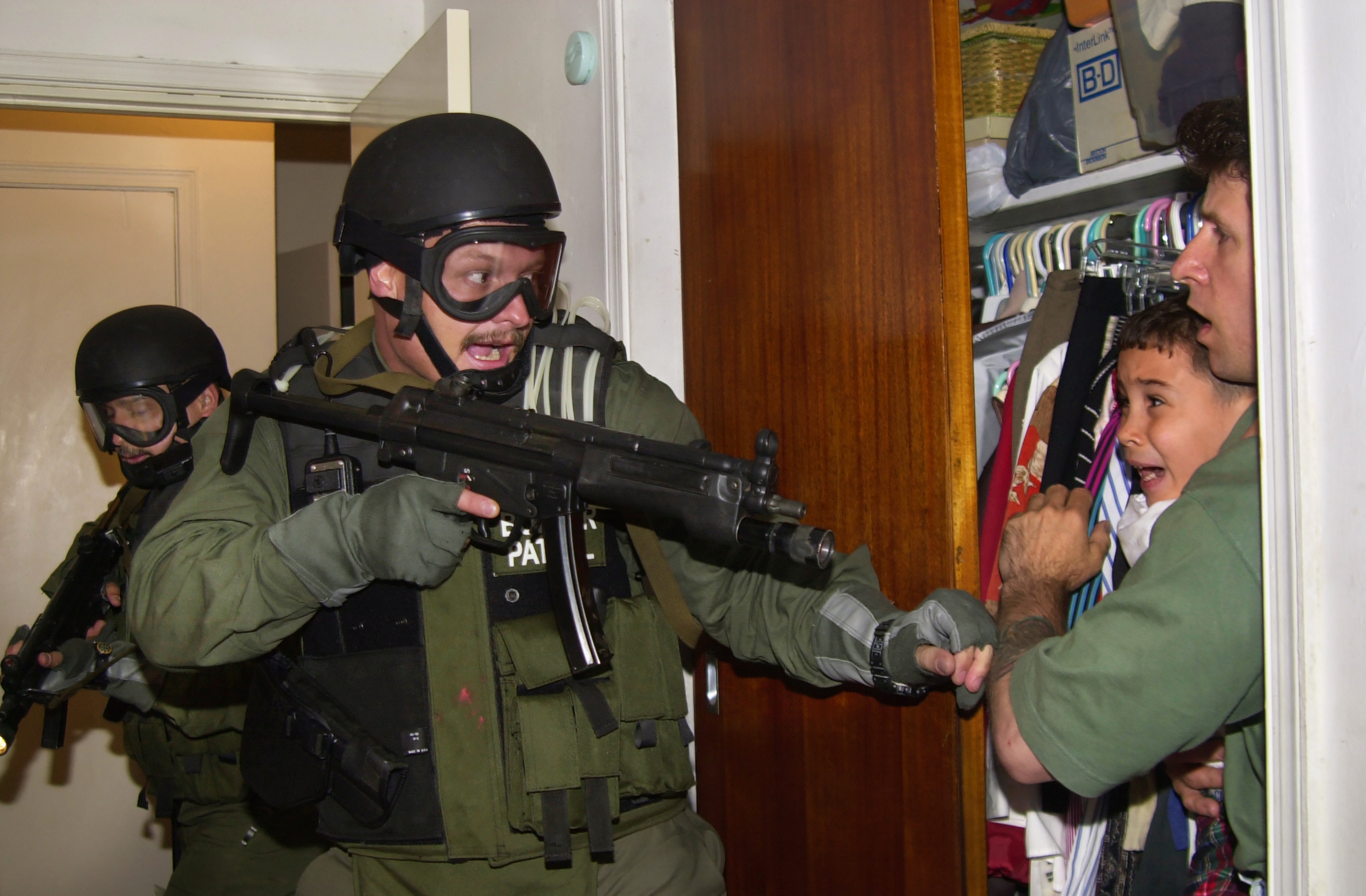 2001: Alan Diaz – “The Taking of Elian.” U.S. federal agents burst through the door of a Miami home on April 22, 2000, as they seize a Cuban boy named Elian Gonzalez. Elian was hiding in a closet with Donato Dalrymple, one of two men who had rescued him from a raft off the Florida coast months earlier. Elian’s U.S. based relatives lost a bitter legal battle with U.S. officials to prevent Elian from being returned to his father in Cuba. The Gonzalez family allowed photographer Alan Diaz to wait for the raid with Dalrymple and the boy.
2001: Alan Diaz – “The Taking of Elian.” U.S. federal agents burst through the door of a Miami home on April 22, 2000, as they seize a Cuban boy named Elian Gonzalez. Elian was hiding in a closet with Donato Dalrymple, one of two men who had rescued him from a raft off the Florida coast months earlier. Elian’s U.S. based relatives lost a bitter legal battle with U.S. officials to prevent Elian from being returned to his father in Cuba. The Gonzalez family allowed photographer Alan Diaz to wait for the raid with Dalrymple and the boy. -
17.
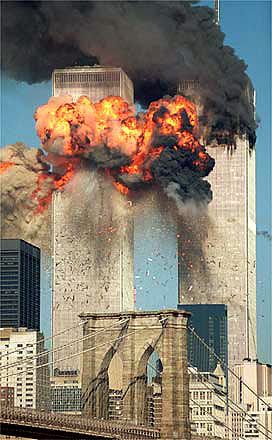 2002: On the morning of Sep 11, 2001, freelance photographer Steve Ludlum was walking along the Brooklyn waterfront when he saw black smoke pouring from the North Tower of the World Trade Center on the other side of the river. Ludlum ran home for his camera and found a friend to drive him to the Manhattan Bridge. Ludlum rested his zoom lens on the iron railing and adjusted his camera. As he was adjusting the camera, United Airlines Flight 175 was headed toward the South Tower. He didn’t see the plane hit, but a ball of fire appeared in his viewfinder. Ludlum released the shutter, thinking all the while it was a bomb. Ludlum’s usual photo lab was too busy, so he went to a one hour drugstore service. Ninety minutes later Ludlum went to the New York Times with his film. The New York Times staff photographers were among the first to arrive at the World Trade Center. Because communications were disrupted, The Times editors had no way of knowing if their photographers were alive. After risking their lives to record the destruction of the World Trade Center, they fought through smoke and falling debris to deliver their film to the Times. Ludlum’s photograph was submitted as part of the Times’ portfolio.
2002: On the morning of Sep 11, 2001, freelance photographer Steve Ludlum was walking along the Brooklyn waterfront when he saw black smoke pouring from the North Tower of the World Trade Center on the other side of the river. Ludlum ran home for his camera and found a friend to drive him to the Manhattan Bridge. Ludlum rested his zoom lens on the iron railing and adjusted his camera. As he was adjusting the camera, United Airlines Flight 175 was headed toward the South Tower. He didn’t see the plane hit, but a ball of fire appeared in his viewfinder. Ludlum released the shutter, thinking all the while it was a bomb. Ludlum’s usual photo lab was too busy, so he went to a one hour drugstore service. Ninety minutes later Ludlum went to the New York Times with his film. The New York Times staff photographers were among the first to arrive at the World Trade Center. Because communications were disrupted, The Times editors had no way of knowing if their photographers were alive. After risking their lives to record the destruction of the World Trade Center, they fought through smoke and falling debris to deliver their film to the Times. Ludlum’s photograph was submitted as part of the Times’ portfolio. -
18.
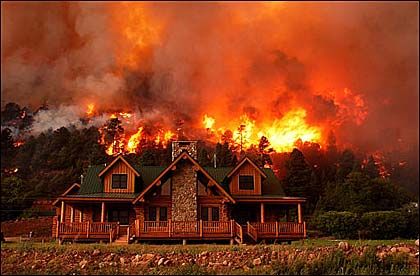 2003: Rocky Mountain News photography staff – “Colorado Wildfires.”
2003: Rocky Mountain News photography staff – “Colorado Wildfires.” -
19.
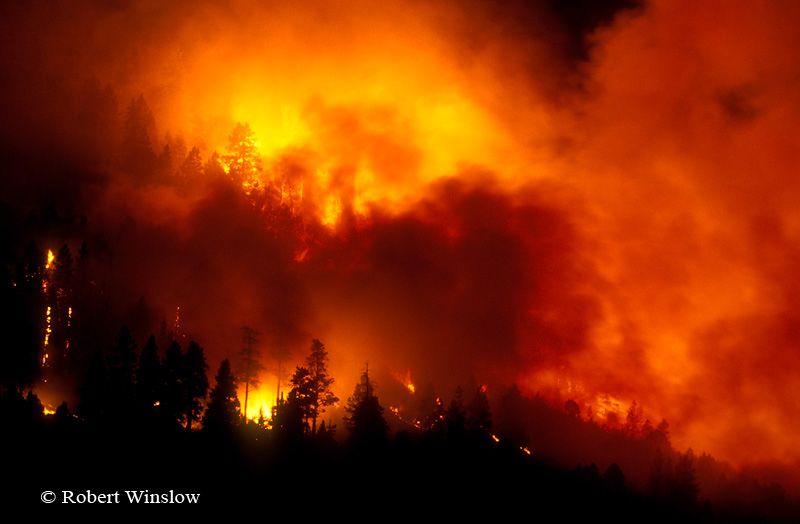 2003 Picture 2
2003 Picture 2 -
20.
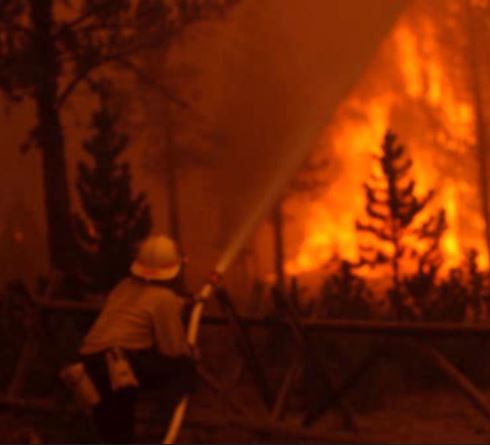 2003 Picture 3
2003 Picture 3 -
21.
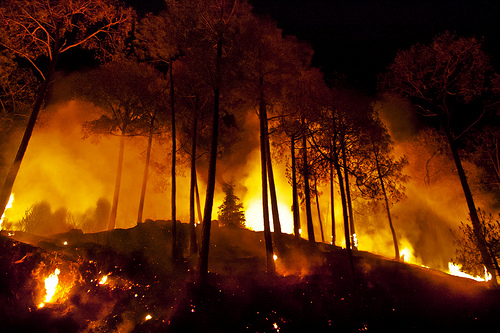 2003 Picture 4
2003 Picture 4 -
22.
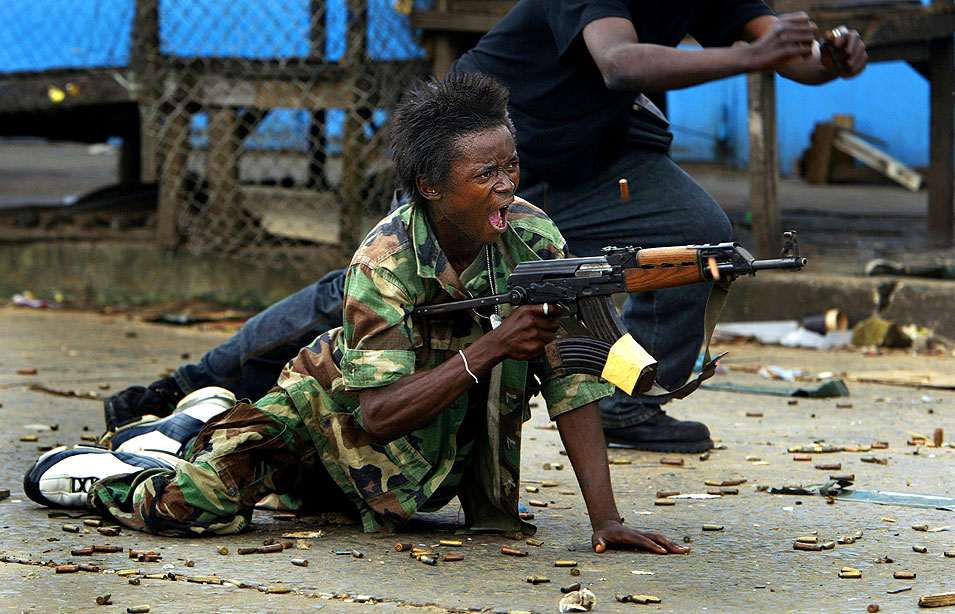 2004: Carolyn Cole – “Second Liberian Civil War.” For her cohesive, behind-the-scenes look at the effects of civil war in Liberia, with special attention to innocent citizens caught in the conflict, and child-soldiers. This picture: “Firing Back.” A government soldier defends a bridge in central Monrovia where a standoff between rebel and government forces held the city under siege.
2004: Carolyn Cole – “Second Liberian Civil War.” For her cohesive, behind-the-scenes look at the effects of civil war in Liberia, with special attention to innocent citizens caught in the conflict, and child-soldiers. This picture: “Firing Back.” A government soldier defends a bridge in central Monrovia where a standoff between rebel and government forces held the city under siege. -
23.
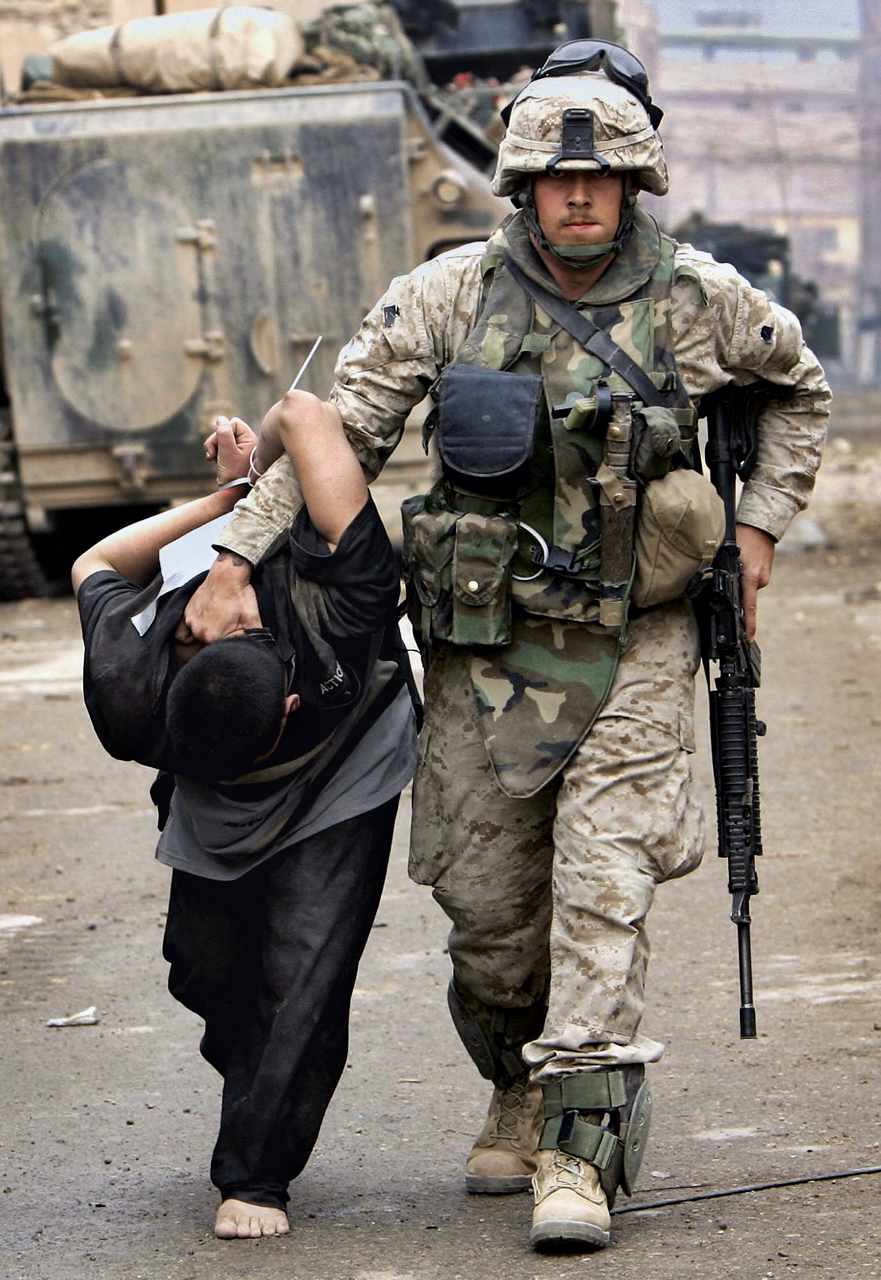 2005: Bilal Hussein, Karim Kadim, Brennan Linsley, Jim MacMillan, Samir Mizban, Khalid Mohammed, John B. Moore, Muhammad Muheisen, Anja Niedringhaus, Murad Sezer and Mohammed Uraibi – “The War in Iraq.” For a stunning photo series on a year of bloody combat inside Iraqi cities. In this picture: A U.S. Marine leads away a captured Iraqi man in the center of Fallujah, Iraq, Nov. 12, 2004.
2005: Bilal Hussein, Karim Kadim, Brennan Linsley, Jim MacMillan, Samir Mizban, Khalid Mohammed, John B. Moore, Muhammad Muheisen, Anja Niedringhaus, Murad Sezer and Mohammed Uraibi – “The War in Iraq.” For a stunning photo series on a year of bloody combat inside Iraqi cities. In this picture: A U.S. Marine leads away a captured Iraqi man in the center of Fallujah, Iraq, Nov. 12, 2004. -
24.
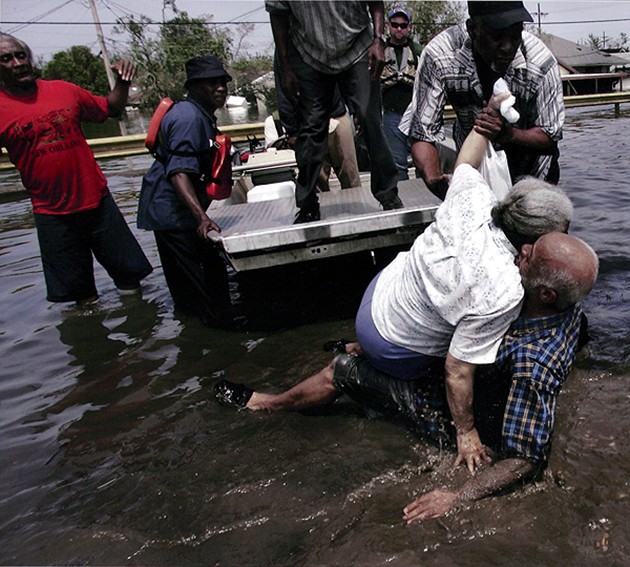 2006: The Staff of the Dallas Morning News – “Hurricane Katrina.” For its vivid photographs depicting the chaos and pain after Hurricane Katrina engulfed New Orleans. In this picture: New Orleans, LA -- Ibry Smith (right) fell as he helped Norma Rankins out of a boat after they were rescued from a nursing home in the Ninth Ward. (Irwin Thompson, August 30, 2005).
2006: The Staff of the Dallas Morning News – “Hurricane Katrina.” For its vivid photographs depicting the chaos and pain after Hurricane Katrina engulfed New Orleans. In this picture: New Orleans, LA -- Ibry Smith (right) fell as he helped Norma Rankins out of a boat after they were rescued from a nursing home in the Ninth Ward. (Irwin Thompson, August 30, 2005). -
25.
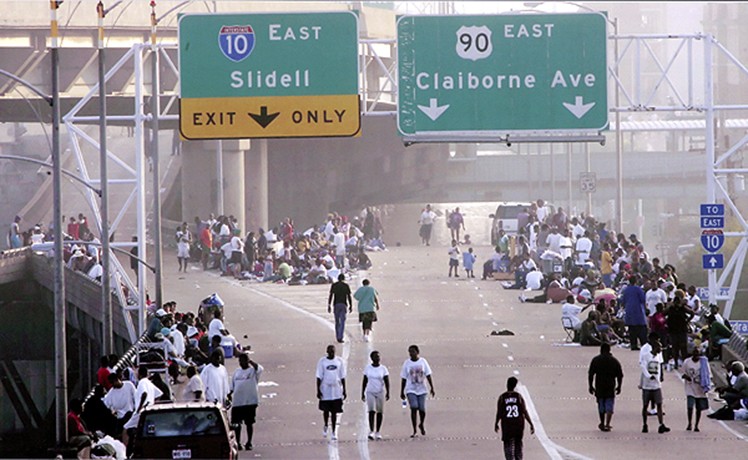 2006 Picture 2: People wandered along Interstate 10 near the Superdome. Amid dire predictions, authorities decided to try to empty the city and move residents from the Superdome to shelters in Dallas and Houston in a two-day caravan of busses (Irwin Thompson, August 31, 2005).
2006 Picture 2: People wandered along Interstate 10 near the Superdome. Amid dire predictions, authorities decided to try to empty the city and move residents from the Superdome to shelters in Dallas and Houston in a two-day caravan of busses (Irwin Thompson, August 31, 2005). -
26.
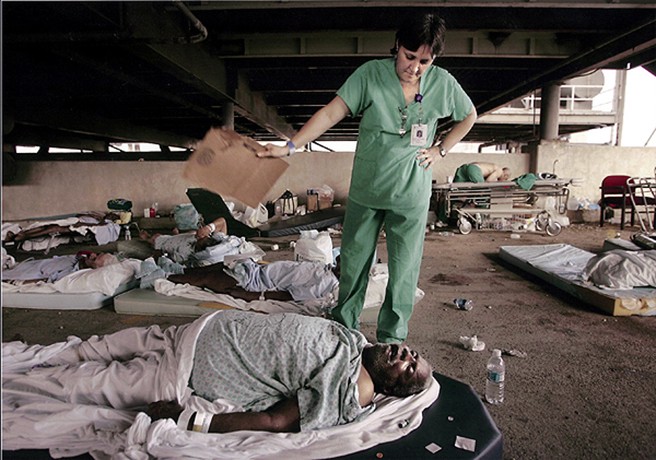 2006 Picture 3: Memorial Medical Center nurse, Mary Jo D'Amico, fanned a patient waiting in the hospital's parking garage for helicopter transport from New Orleans (Brad Loper, September 1, 2005).
2006 Picture 3: Memorial Medical Center nurse, Mary Jo D'Amico, fanned a patient waiting in the hospital's parking garage for helicopter transport from New Orleans (Brad Loper, September 1, 2005). -
27.
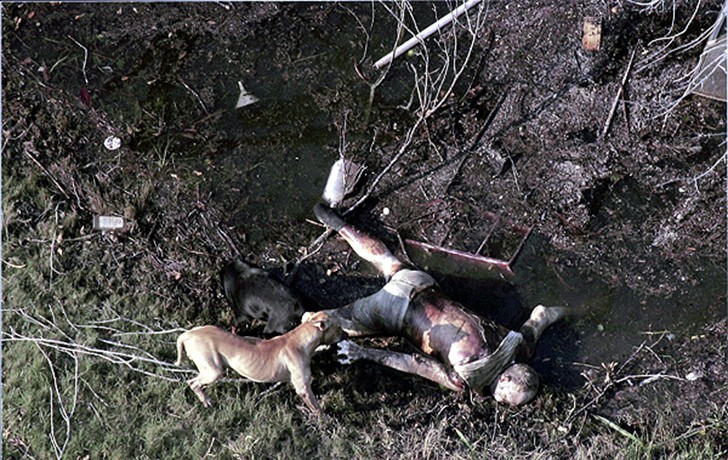 2006 Picture 4: Hungry dogs fed on a corpse washed up at the edge of receding floodwaters (Smiley N. Pool, September 4, 2005).
2006 Picture 4: Hungry dogs fed on a corpse washed up at the edge of receding floodwaters (Smiley N. Pool, September 4, 2005). -
28.
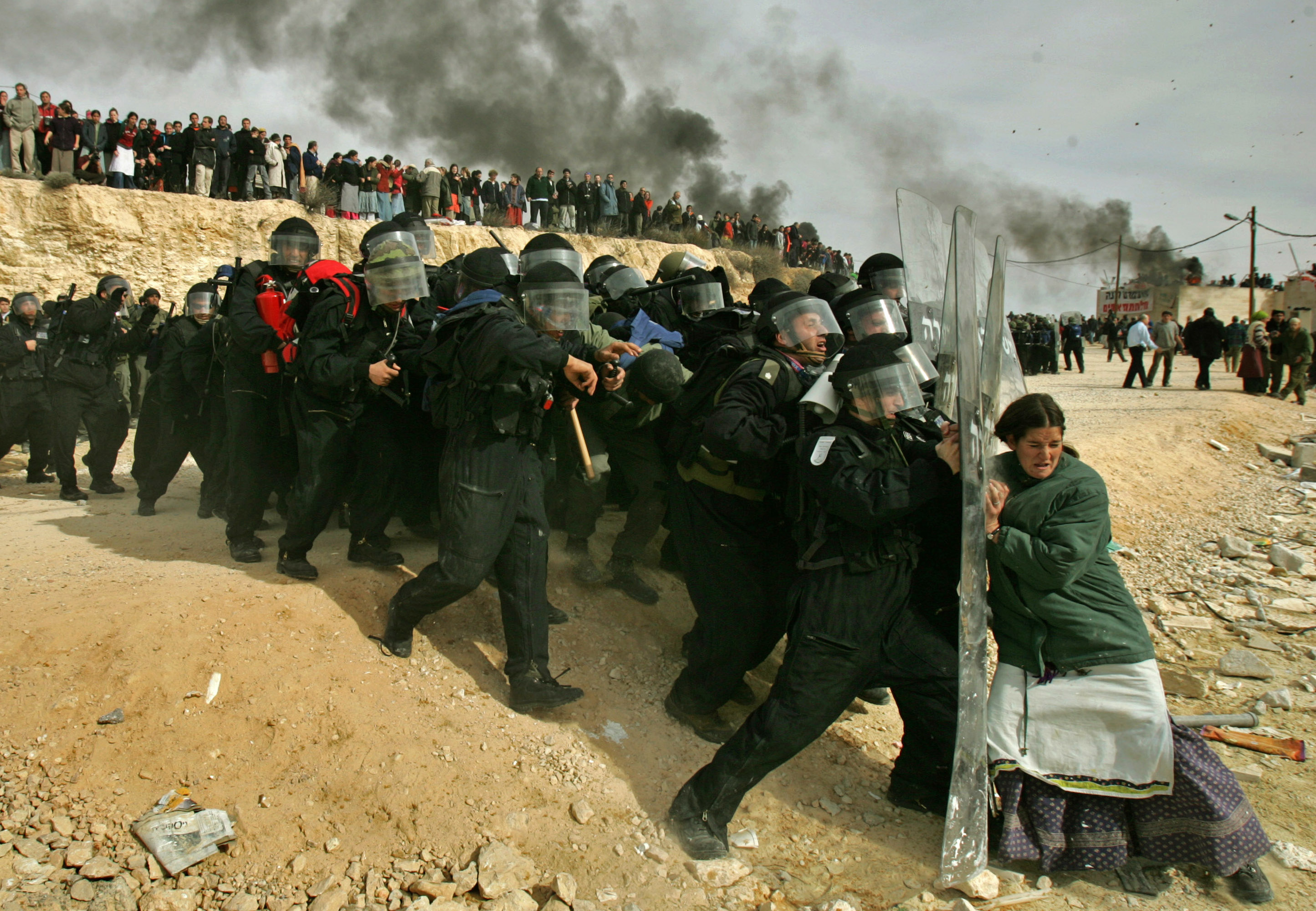 2007: Oded Balilty – “West Bank Jewish Woman.” A lone Jewish settler challenges Israeli security officers during clashes that erupted as authorities cleared the West Bank settlement of Amona, east of the Palestinian town of Ramallah, Feb. 1, 2006. Thousands of troops in riot gear and on horseback clashed with hundreds of stone-throwing Jewish settlers holed up in this illegal West Bank outpost after Israel’s Supreme Court cleared the way for demolition of nine homes at the site.
2007: Oded Balilty – “West Bank Jewish Woman.” A lone Jewish settler challenges Israeli security officers during clashes that erupted as authorities cleared the West Bank settlement of Amona, east of the Palestinian town of Ramallah, Feb. 1, 2006. Thousands of troops in riot gear and on horseback clashed with hundreds of stone-throwing Jewish settlers holed up in this illegal West Bank outpost after Israel’s Supreme Court cleared the way for demolition of nine homes at the site. -
29.
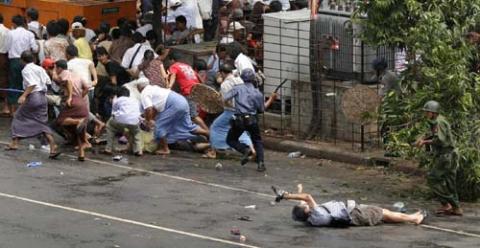 2008: Adrees Latif – “Kenji Nagai.” This is the winning photograph showing wounded Japanese photographer Kenji Nagai as he lay before a Burmese soldier in Yangon, Myanmar, as troops attacked protesters. Nagai later died. Nagai had been in Myanmar covering the anti-government protests since Tuesday, September 25. On Thursday, September 27, Nagai was photographing the protests near the Traders Hotel, a few blocks away from the Sule Pagoda in downtown Yangon, when soldiers opened fire on demonstrators, killing Nagai and reportedly injuring another foreign journalist. Reports initially stated that Nagai was hit by stray bullets fired by soldiers or possibly shot from the front. The "stray bullet" explanation was proposed by the government of Myanmar as an explanation for Nagai's death. However, video footage obtained by Japanese television appears to show a Burmese soldier shoving Nagai to the ground and shooting him at point-blank range. A still image photographed by Adrees Latif showed the soldier standing over Nagai, who was sprawled on the ground and still clutching his camera. This photograph appeared on the front page of The New York Times on September 28, 2007. A subsequent shot showed Nagai's body sprawled in the street as the soldier walked away. At the Japanese embassy in Myanmar, a physician established the trajectory of the fatal bullet that killed Nagai, determining that the bullet entered Nagai's chest from the lower right side and pierced his heart before exiting from his back. In the next picture you can see the apparent bullet wound on the bottom right side of Nagai’s chest. On October 8, new footage showing how a Burmese soldier apparently confiscating a fallen Nagai's video camera was revealed on a Japanese news show. Adrees Latif's photo, depicting Nagai sprawling on the pavement before his death, won the Pulitzer Prize for Breaking News.
2008: Adrees Latif – “Kenji Nagai.” This is the winning photograph showing wounded Japanese photographer Kenji Nagai as he lay before a Burmese soldier in Yangon, Myanmar, as troops attacked protesters. Nagai later died. Nagai had been in Myanmar covering the anti-government protests since Tuesday, September 25. On Thursday, September 27, Nagai was photographing the protests near the Traders Hotel, a few blocks away from the Sule Pagoda in downtown Yangon, when soldiers opened fire on demonstrators, killing Nagai and reportedly injuring another foreign journalist. Reports initially stated that Nagai was hit by stray bullets fired by soldiers or possibly shot from the front. The "stray bullet" explanation was proposed by the government of Myanmar as an explanation for Nagai's death. However, video footage obtained by Japanese television appears to show a Burmese soldier shoving Nagai to the ground and shooting him at point-blank range. A still image photographed by Adrees Latif showed the soldier standing over Nagai, who was sprawled on the ground and still clutching his camera. This photograph appeared on the front page of The New York Times on September 28, 2007. A subsequent shot showed Nagai's body sprawled in the street as the soldier walked away. At the Japanese embassy in Myanmar, a physician established the trajectory of the fatal bullet that killed Nagai, determining that the bullet entered Nagai's chest from the lower right side and pierced his heart before exiting from his back. In the next picture you can see the apparent bullet wound on the bottom right side of Nagai’s chest. On October 8, new footage showing how a Burmese soldier apparently confiscating a fallen Nagai's video camera was revealed on a Japanese news show. Adrees Latif's photo, depicting Nagai sprawling on the pavement before his death, won the Pulitzer Prize for Breaking News. -
30.
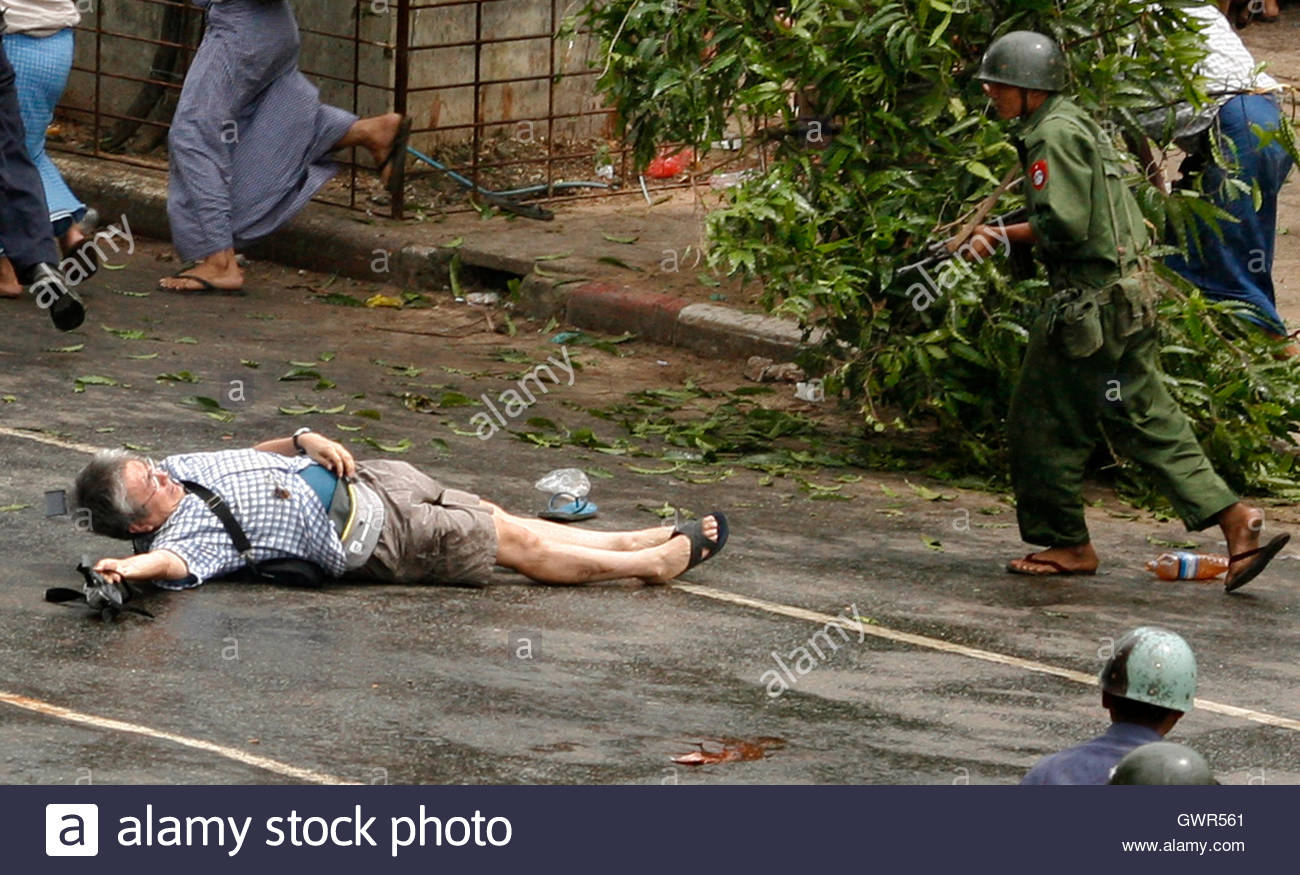 2008 Picture 2: The bullet wound is visible at the bottom right side of Nagai’s chest.
2008 Picture 2: The bullet wound is visible at the bottom right side of Nagai’s chest. -
31.
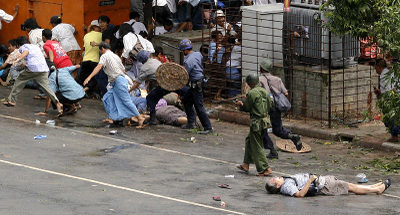 2008 Picture 3: The soldier walking past Nagai.
2008 Picture 3: The soldier walking past Nagai. -
32.
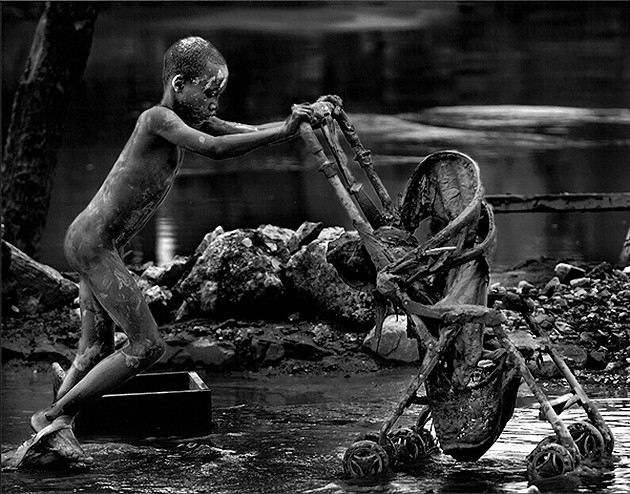 2009: Patrick Farrell – “After the Storm.” In 2008, the Miami Herald repeatedly sent Farrell to Haiti, which bore the brunt of the year’s Atlantic Hurricane Season. He was there the night Hurricane Ike - the fourth storm to hit Haiti in a month – re-flooded the overwhelmed country, swallowing homes and lives. In all, more than 800 Haitians died and more than 1 million were left homeless by the unrelenting series of storms.
2009: Patrick Farrell – “After the Storm.” In 2008, the Miami Herald repeatedly sent Farrell to Haiti, which bore the brunt of the year’s Atlantic Hurricane Season. He was there the night Hurricane Ike - the fourth storm to hit Haiti in a month – re-flooded the overwhelmed country, swallowing homes and lives. In all, more than 800 Haitians died and more than 1 million were left homeless by the unrelenting series of storms. -
33.
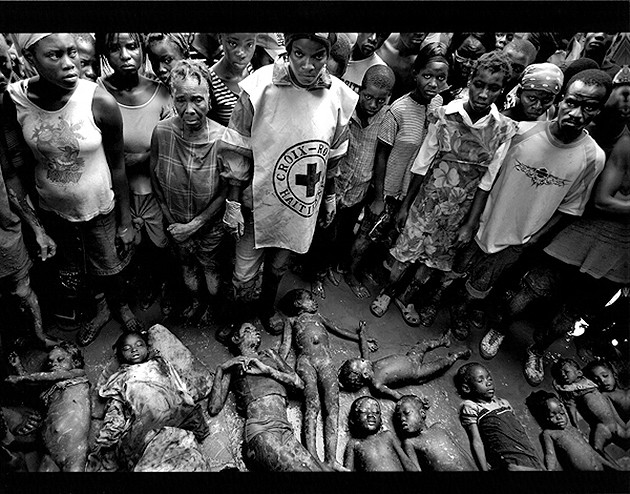 2009 Picture 2
2009 Picture 2 -
34.
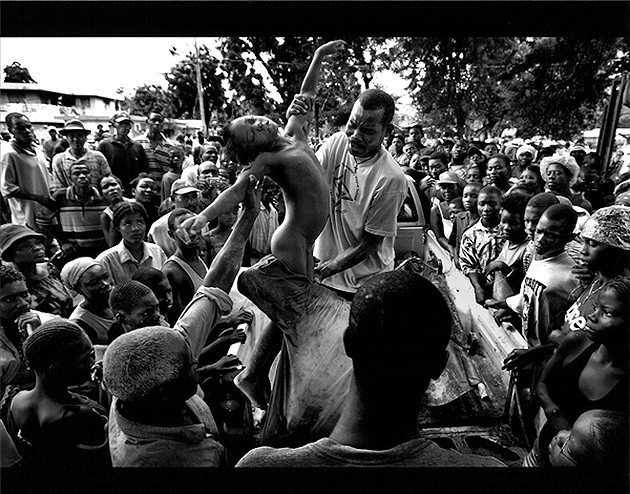 2009 Picture 3
2009 Picture 3 -
35.
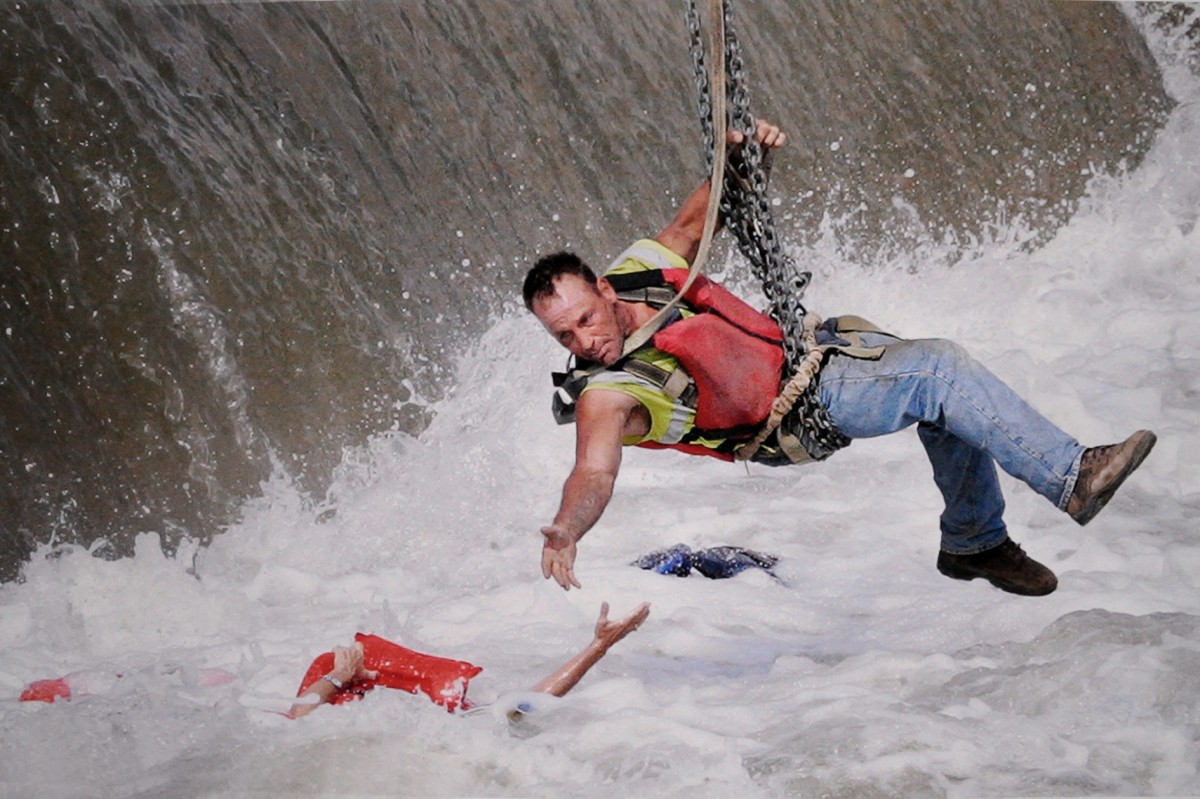 2010: Mary Chind – “River Rescue.” A woman is pulled from near the Center Street dam by construction worker Jason Oglesbee. A man who was with the unidentified woman died in the Des Moines River. A rescue team from the Des Moines Fire Department tried several times to rescue the woman but could not get close enough to her.
2010: Mary Chind – “River Rescue.” A woman is pulled from near the Center Street dam by construction worker Jason Oglesbee. A man who was with the unidentified woman died in the Des Moines River. A rescue team from the Des Moines Fire Department tried several times to rescue the woman but could not get close enough to her. -
36.
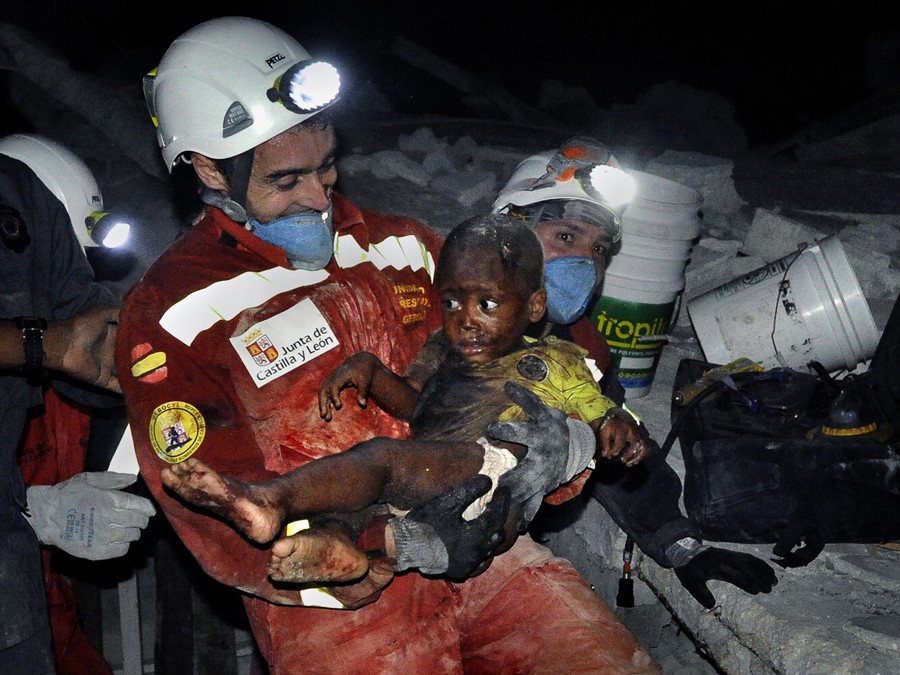 2011: Carol Guzy, Nikki Kahn and Ricky Carioti – “Earthquake Aftermath in Haiti.” These photographers from the The Washington Post were sent to Haiti after a devastating earthquake struck the country. This picture: “Rescue” Relief efforts were severely hampered by the fact that government agencies and international organizations charged with helping coordinate assistance operations had themselves been shattered by the quake. But there were moments of hope amid the despair: A tiny baby named Reggie Claude is rescued from the rubble of his home. Disaster relief workers and family members rejoiced as Oscar Vega carried the child through the streets.
2011: Carol Guzy, Nikki Kahn and Ricky Carioti – “Earthquake Aftermath in Haiti.” These photographers from the The Washington Post were sent to Haiti after a devastating earthquake struck the country. This picture: “Rescue” Relief efforts were severely hampered by the fact that government agencies and international organizations charged with helping coordinate assistance operations had themselves been shattered by the quake. But there were moments of hope amid the despair: A tiny baby named Reggie Claude is rescued from the rubble of his home. Disaster relief workers and family members rejoiced as Oscar Vega carried the child through the streets. -
37.
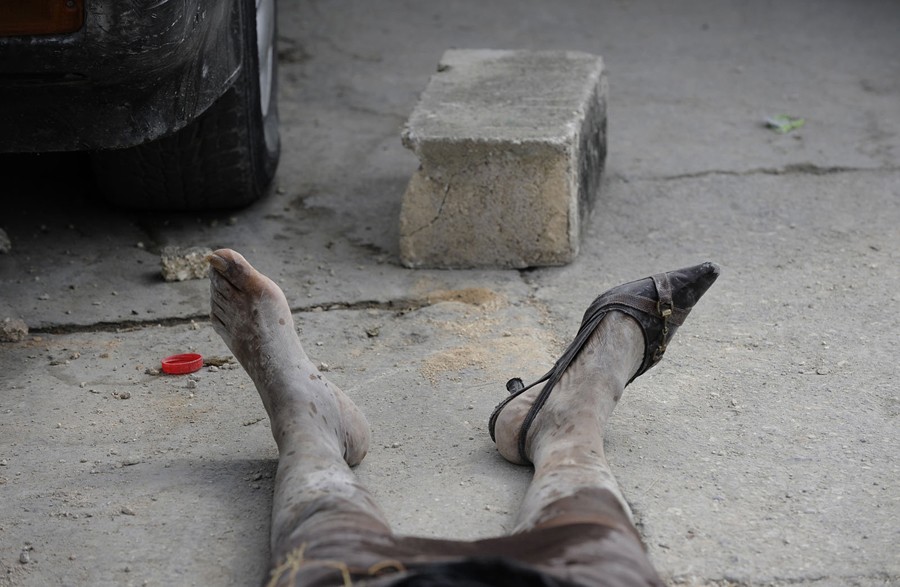 2011: Picture 2: “The Moment Time Stopped” The quake's epicenter was about 10 miles west of Port-au-Prince, home to as much as a third of the country's population. Survivors piled bodies of the dead outside for weeks after the earth’s spasm. Haiti has a troubled history, plagued by poverty and political turmoil. The devastation wrought by nature was yet another profound sorrow for the Haitian heart to endure.
2011: Picture 2: “The Moment Time Stopped” The quake's epicenter was about 10 miles west of Port-au-Prince, home to as much as a third of the country's population. Survivors piled bodies of the dead outside for weeks after the earth’s spasm. Haiti has a troubled history, plagued by poverty and political turmoil. The devastation wrought by nature was yet another profound sorrow for the Haitian heart to endure. -
38.
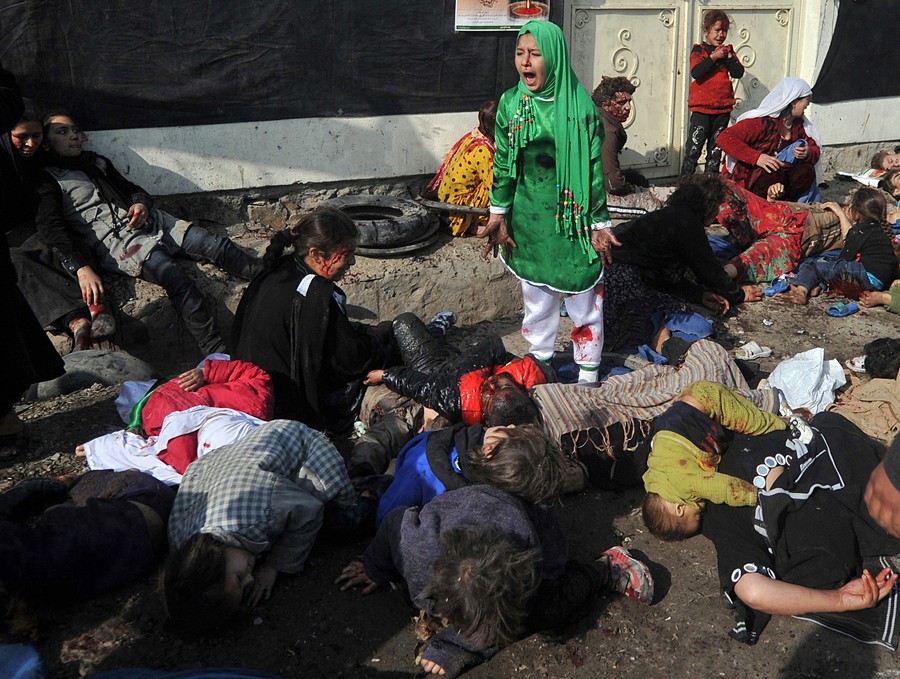 2012: Massoud Hossaini – “The Girl in the Green Dress.” Tarana Akbari, 12, screams in fear moments after a suicide bomber detonated a bomb in a crowd at the Abul Fazel Shrine in Kabul on December 06, 2011. 'When I could stand up, I saw that everybody was around me on the ground, really bloody. I was really, really scared,' said the Tarana, whose name means 'melody' in English. Out of 17 women and children from her family who went to a riverside shrine in Kabul that day to mark the Shiite holy day of Ashura, seven died including her seven-year-old brother Shoaib. More than 70 people lost their lives in all, and at least nine other members of Tarana's family were wounded. The blasts has prompted fears that Afghanistan could see the sort of sectarian violence that has pitched Shiite against Sunni Muslims in Iraq and Pakistan. The attack was the deadliest strike on the capital in three years. President Hamid Karzai said this was the first time insurgents had struck on such an important religious day. The Taliban condemned the attack, which some official viewed as sectarian.
2012: Massoud Hossaini – “The Girl in the Green Dress.” Tarana Akbari, 12, screams in fear moments after a suicide bomber detonated a bomb in a crowd at the Abul Fazel Shrine in Kabul on December 06, 2011. 'When I could stand up, I saw that everybody was around me on the ground, really bloody. I was really, really scared,' said the Tarana, whose name means 'melody' in English. Out of 17 women and children from her family who went to a riverside shrine in Kabul that day to mark the Shiite holy day of Ashura, seven died including her seven-year-old brother Shoaib. More than 70 people lost their lives in all, and at least nine other members of Tarana's family were wounded. The blasts has prompted fears that Afghanistan could see the sort of sectarian violence that has pitched Shiite against Sunni Muslims in Iraq and Pakistan. The attack was the deadliest strike on the capital in three years. President Hamid Karzai said this was the first time insurgents had struck on such an important religious day. The Taliban condemned the attack, which some official viewed as sectarian. -
39.
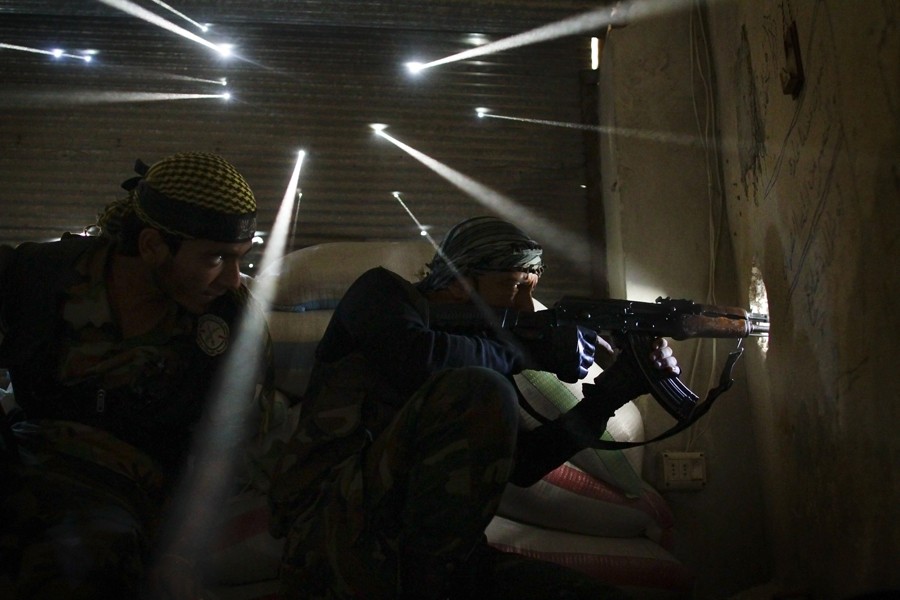 2013: Javier Manzano – “Syrian Rebels.” This picture was taken on Oct 18, 2012 and shows two rebel soldiers in Syria guarding their position in the Karmel Jabl neighborhood of Aleppo, as light streams through more than a dozen holes made by bullets and shrapnel in the tin wall behind them. The dust from more than one hundred days of shelling, bombing and firefights hung in the air. Karmel Jabl is strategically important because of its proximity to the main road that separates several of the main battlegrounds in the city.
2013: Javier Manzano – “Syrian Rebels.” This picture was taken on Oct 18, 2012 and shows two rebel soldiers in Syria guarding their position in the Karmel Jabl neighborhood of Aleppo, as light streams through more than a dozen holes made by bullets and shrapnel in the tin wall behind them. The dust from more than one hundred days of shelling, bombing and firefights hung in the air. Karmel Jabl is strategically important because of its proximity to the main road that separates several of the main battlegrounds in the city. -
40.
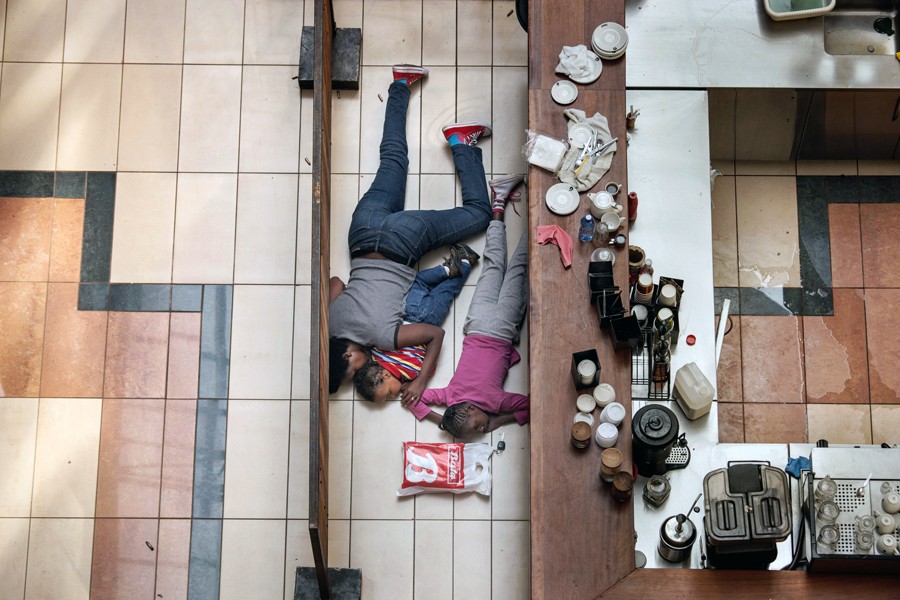 2014: Tyler Hicks – “Westgate Mall in Kenya.” For his compelling pictures that showed skill and bravery in documenting the unfolding terrorist attack at Westgate mall in Kenya. In this picture: A woman tried to shelter children from gunfire by Somali militants at the Westgate mall in Nairobi, Kenya, in an attack that killed more than 70 people. Tyler Hicks made this photo from a floor above, in an exposed area where the police feared for his safety.
2014: Tyler Hicks – “Westgate Mall in Kenya.” For his compelling pictures that showed skill and bravery in documenting the unfolding terrorist attack at Westgate mall in Kenya. In this picture: A woman tried to shelter children from gunfire by Somali militants at the Westgate mall in Nairobi, Kenya, in an attack that killed more than 70 people. Tyler Hicks made this photo from a floor above, in an exposed area where the police feared for his safety. -
41.
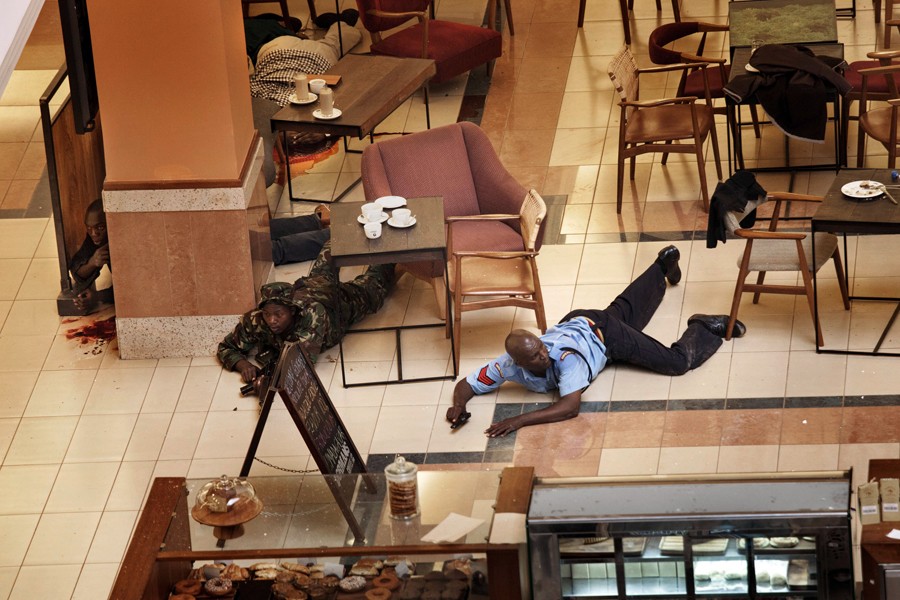 2014 Picture 2: In a hastily abandoned cafe, soldiers and security officers tried to isolate the attackers and herd civilians to safety. They found many bodies in stores.
2014 Picture 2: In a hastily abandoned cafe, soldiers and security officers tried to isolate the attackers and herd civilians to safety. They found many bodies in stores. -
42.
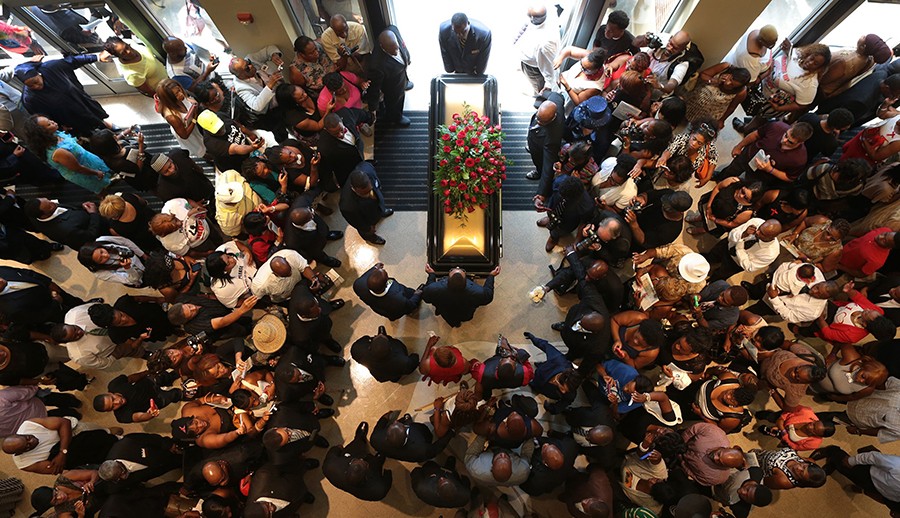 2015: Photography Staff of St. Louis Post-Dispatch – “Despair and Anger in Ferguson, MO.” For powerful images of the civil unrest in Ferguson, MO, stunning photojournalism that served the community while informing the country after the fatal shooting of Michael Brown by white police officer Darren Wilson on August 9, 2014 In this picture: The casket of Michael Brown exits Friendly Temple Missionary Baptist Church at the end of his St. Louis funeral. Thousands of mourners filled the church and lined the streets for Brown's farewell.
2015: Photography Staff of St. Louis Post-Dispatch – “Despair and Anger in Ferguson, MO.” For powerful images of the civil unrest in Ferguson, MO, stunning photojournalism that served the community while informing the country after the fatal shooting of Michael Brown by white police officer Darren Wilson on August 9, 2014 In this picture: The casket of Michael Brown exits Friendly Temple Missionary Baptist Church at the end of his St. Louis funeral. Thousands of mourners filled the church and lined the streets for Brown's farewell. -
43.
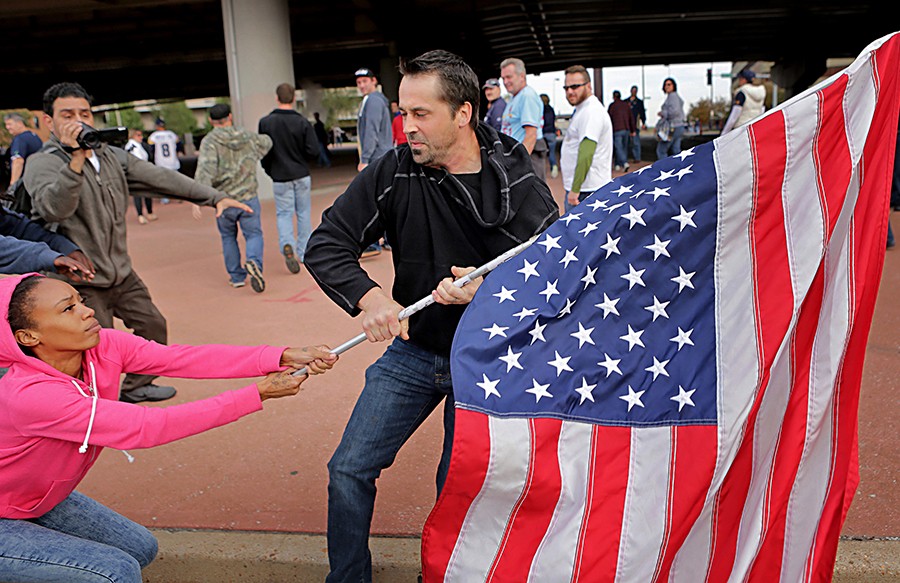 2015 Picture 2: Ferguson protester Cheyenne Green struggles to hold onto an American flag as a football fan makes a grab for it outside the Edward Jones Dome after a St. Louis Rams game.
2015 Picture 2: Ferguson protester Cheyenne Green struggles to hold onto an American flag as a football fan makes a grab for it outside the Edward Jones Dome after a St. Louis Rams game. -
44.
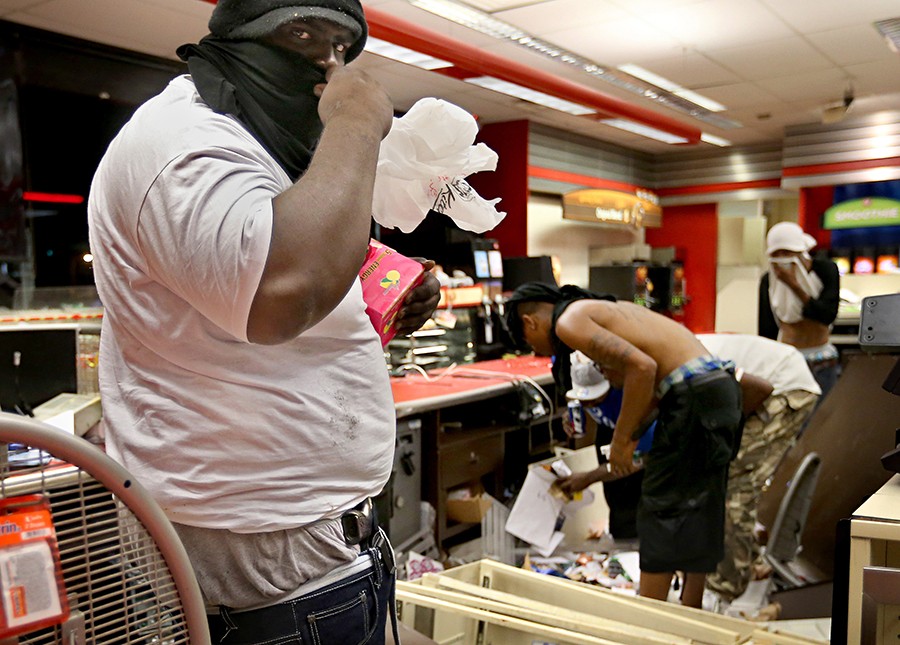 2015 Picture 3: A looter armed with a gun in his waistband steals items from a QuikTrip after riots broke out at the end of a candlelight vigil for Michael Brown. The store was later set afire.
2015 Picture 3: A looter armed with a gun in his waistband steals items from a QuikTrip after riots broke out at the end of a candlelight vigil for Michael Brown. The store was later set afire. -
45.
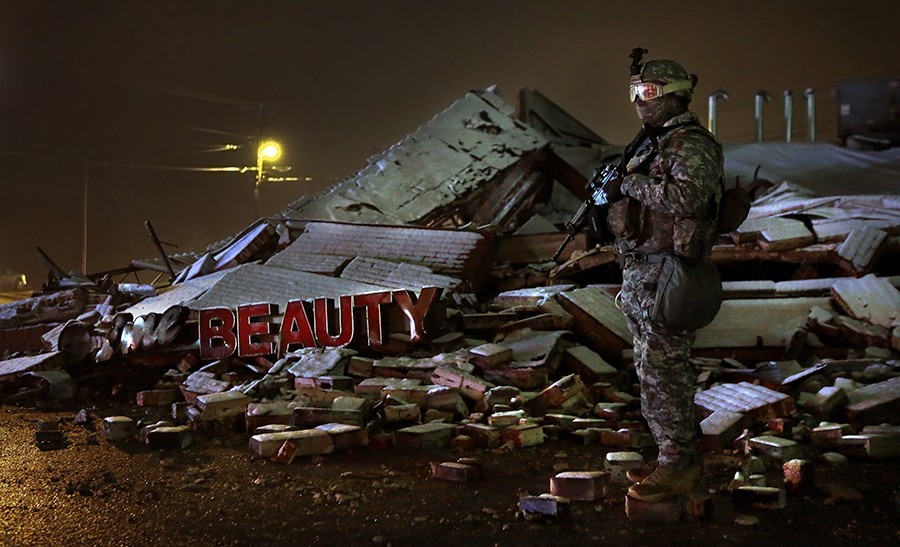 2015 Picture 4: A Missouri National Guardsman stands over the rubble of Prime Beauty Supply in Ferguson. Though Gov. Jay Nixon had activated the guardsmen several days before the grand jury's verdict was announced, they were kept out of Ferguson until the following day.
2015 Picture 4: A Missouri National Guardsman stands over the rubble of Prime Beauty Supply in Ferguson. Though Gov. Jay Nixon had activated the guardsmen several days before the grand jury's verdict was announced, they were kept out of Ferguson until the following day. -
46.
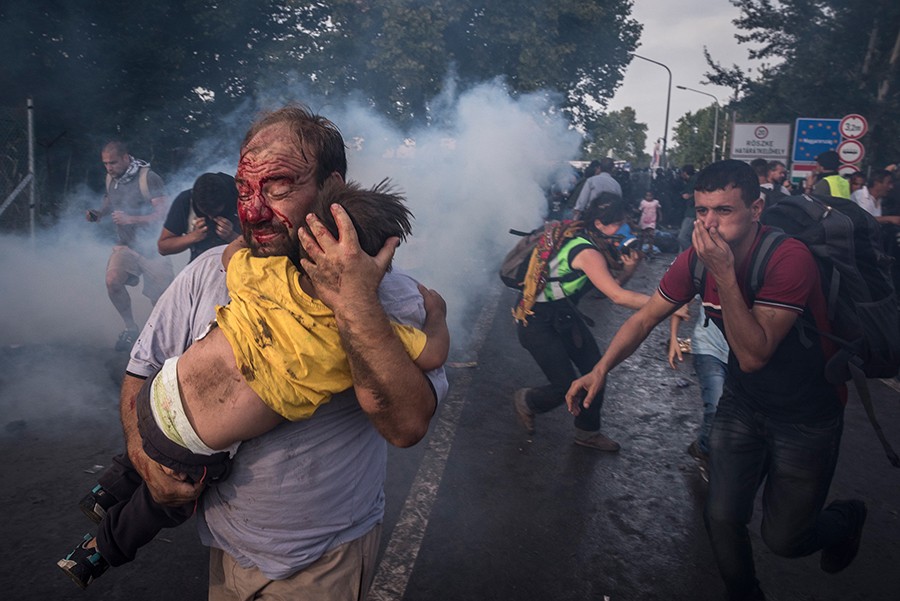 2016: Mauricio Lima, Sergey Ponomarev, Tyler Hicks and Daniel Etter of The New York Times – “Refugees.” For photographs that captured the resolve of refugees, the perils of their journeys and the struggle of host countries to take them in. In this picture: A man tries to shield his child from police beatings and tear gas at the border crossing in Horgos, Serbia. Baton-wielding Hungarian riot police unleashed tear gas and water cannons against hundreds of migrants after they broke through a razor-wire fence and tried to surge into Hungary from Serbia.
2016: Mauricio Lima, Sergey Ponomarev, Tyler Hicks and Daniel Etter of The New York Times – “Refugees.” For photographs that captured the resolve of refugees, the perils of their journeys and the struggle of host countries to take them in. In this picture: A man tries to shield his child from police beatings and tear gas at the border crossing in Horgos, Serbia. Baton-wielding Hungarian riot police unleashed tear gas and water cannons against hundreds of migrants after they broke through a razor-wire fence and tried to surge into Hungary from Serbia. -
47.
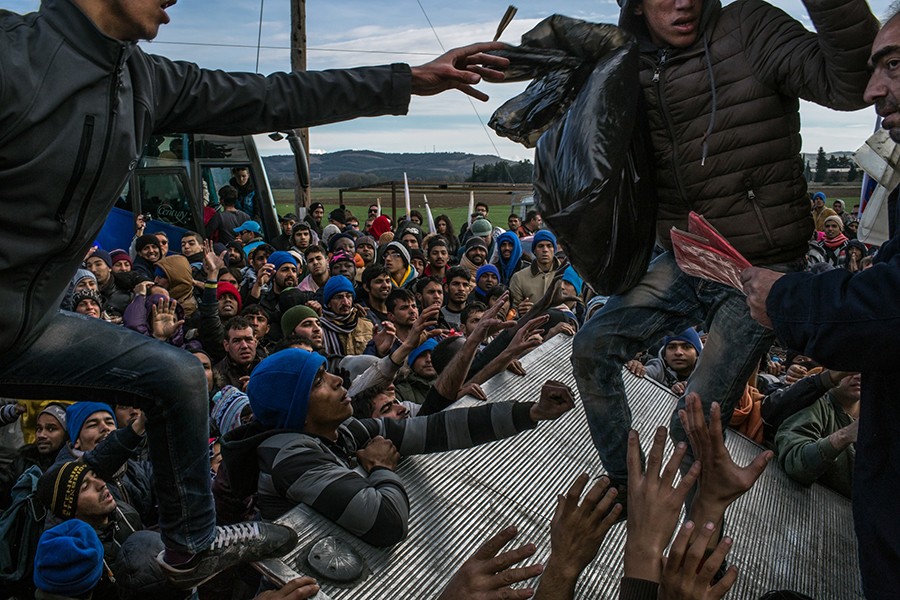 2016 (2): November 28, 2015. Refugees from Pakistan, Bangladesh, Morocco, Algeria and Somalia struggling for donations of water, blankets, diapers and some clothes on their 10th day encamped near the border in Idomeni, Greece. They were not allowed to cross into Macedonia; only refugees from Afghanistan, Iraq and Syria were allowed to cross and continue their journeys.
2016 (2): November 28, 2015. Refugees from Pakistan, Bangladesh, Morocco, Algeria and Somalia struggling for donations of water, blankets, diapers and some clothes on their 10th day encamped near the border in Idomeni, Greece. They were not allowed to cross into Macedonia; only refugees from Afghanistan, Iraq and Syria were allowed to cross and continue their journeys. -
48.
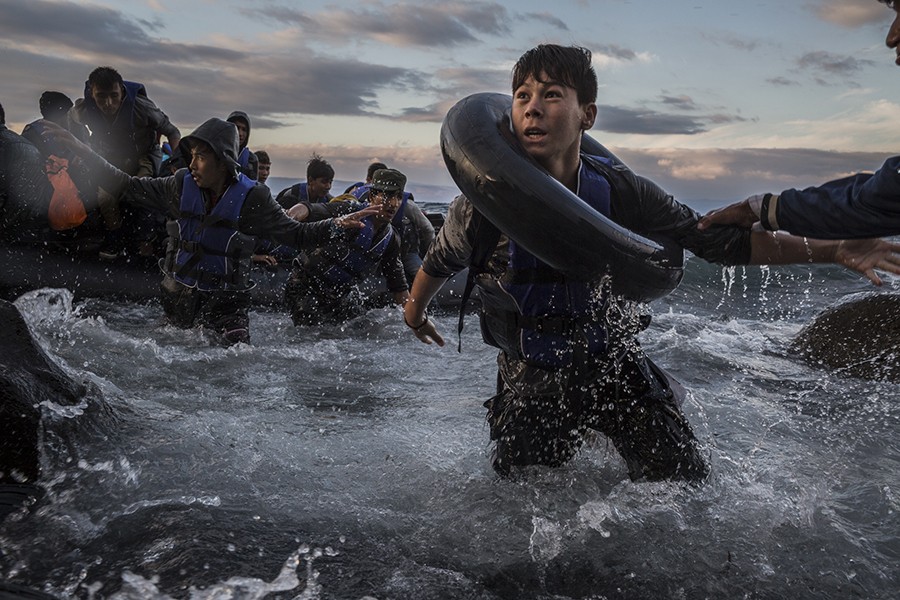 2016 Picture 2: After battling rough seas and high winds from Turkey, migrants arrive by rubber raft on a jagged shoreline of the Greek island of Lesbos. Fearing capsize or puncture, some panicked and jumped into the cold water in desperation to reach land. This young boy made it, unlike hundreds of others
2016 Picture 2: After battling rough seas and high winds from Turkey, migrants arrive by rubber raft on a jagged shoreline of the Greek island of Lesbos. Fearing capsize or puncture, some panicked and jumped into the cold water in desperation to reach land. This young boy made it, unlike hundreds of others -
49.
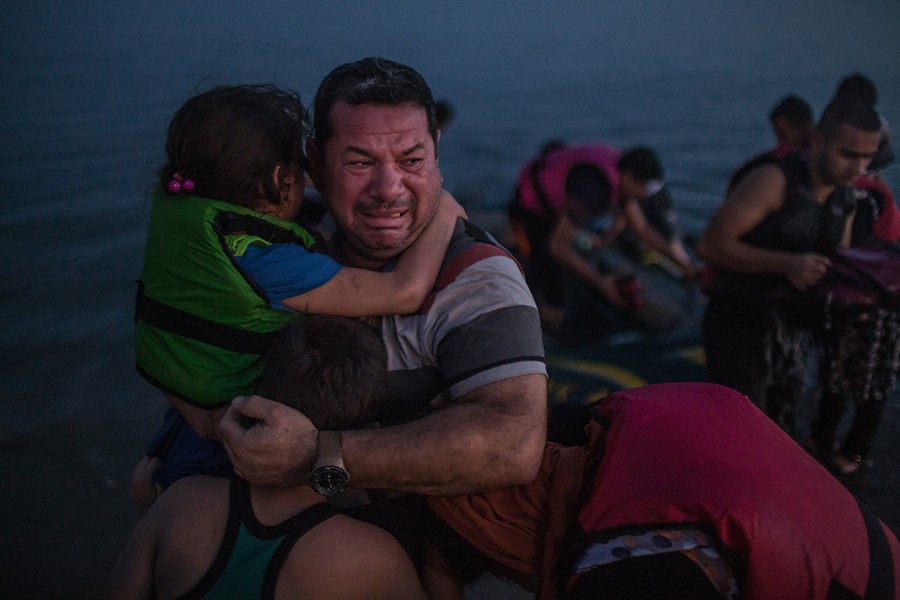 2016: (4): Laith Majid, an Iraqi, broke out in tears, holding his son and daughter after they arrived safely in Kos, Greece, on a flimsy rubber boat.
2016: (4): Laith Majid, an Iraqi, broke out in tears, holding his son and daughter after they arrived safely in Kos, Greece, on a flimsy rubber boat. -
50.
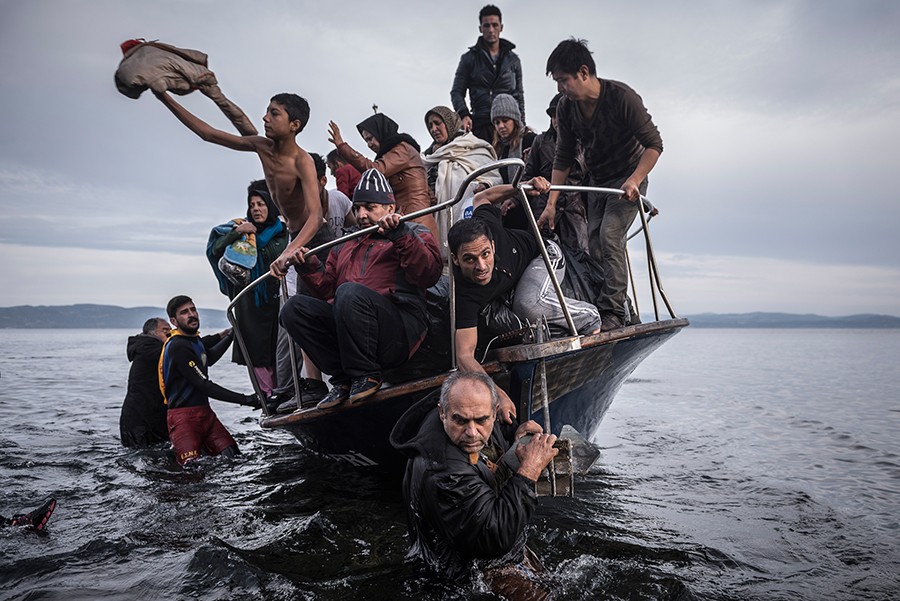 2016 Picture 3: Migrants arrive by a Turkish boat near the village of Skala, on the Greek island of Lesbos. The Turkish boat owner delivered some 150 people to the Greek coast and tried to escape back to Turkey; he was arrested in Turkish waters.
2016 Picture 3: Migrants arrive by a Turkish boat near the village of Skala, on the Greek island of Lesbos. The Turkish boat owner delivered some 150 people to the Greek coast and tried to escape back to Turkey; he was arrested in Turkish waters.
- REPLAY GALLERY
-
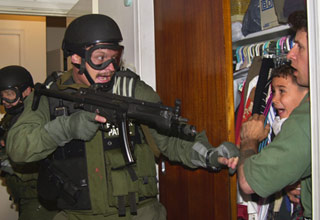
- Pulitzer Prize Winning Photographs: Part Two
- NEXT GALLERY
-
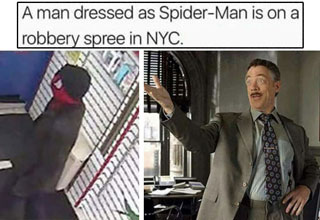
- 36 Great Pics And Memes To Improve Your Mood
1986: Tom Gralish – “Philadelphia’s Homeless.” In winter of 1985 Gralish visited the city’s homeless and encountered Walter. “I like any kind of food,” said Walter. Whatever’s there. Hotdog one day, the next Chinese food, roast beef sandwich…” Walter lives on a sidewalk heating grate and is one of those guys who is hard to reach because he talks to himself and rants to people on the street. Everyone knows him; people who live and work in the neighborhood give him change. Eventually, Walter allowed Gralish to photograph him. “People like it when you pay attention to them. These guys had disdain for society and the rules, that’s why they objected to the shelters. They saw themselves as the last free men.”
50/50
1/50


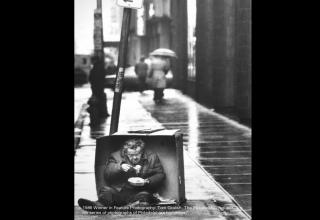
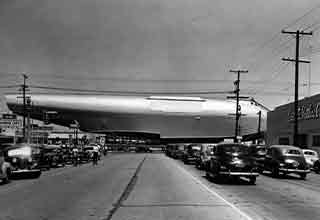
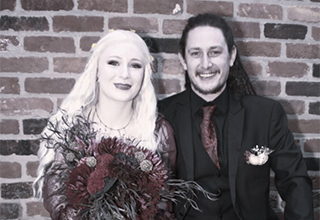
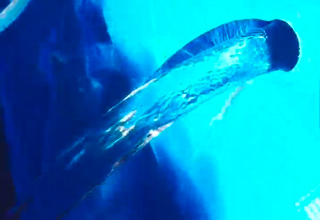


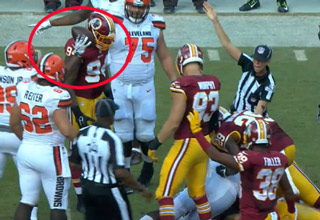
3 Comments